Enhancing My Skills for International Managerial Role
VerifiedAdded on 2019/09/16
|21
|7167
|298
Report
AI Summary
The assignment is about identifying personal and professional development areas to improve a role at the international level. The author has taken a test, 'How do you fit the design' which revealed their strengths and weaknesses. They have identified four areas for improvement: (1) understanding the culture of other countries; (2) improving analytical skills; (3) managing time effectively; and (4) developing strategies to learn new things. To achieve these goals, they plan to engage in personal development activities such as traveling, e-learning, attending training sessions, and seminars.
Contribute Materials
Your contribution can guide someone’s learning journey. Share your
documents today.
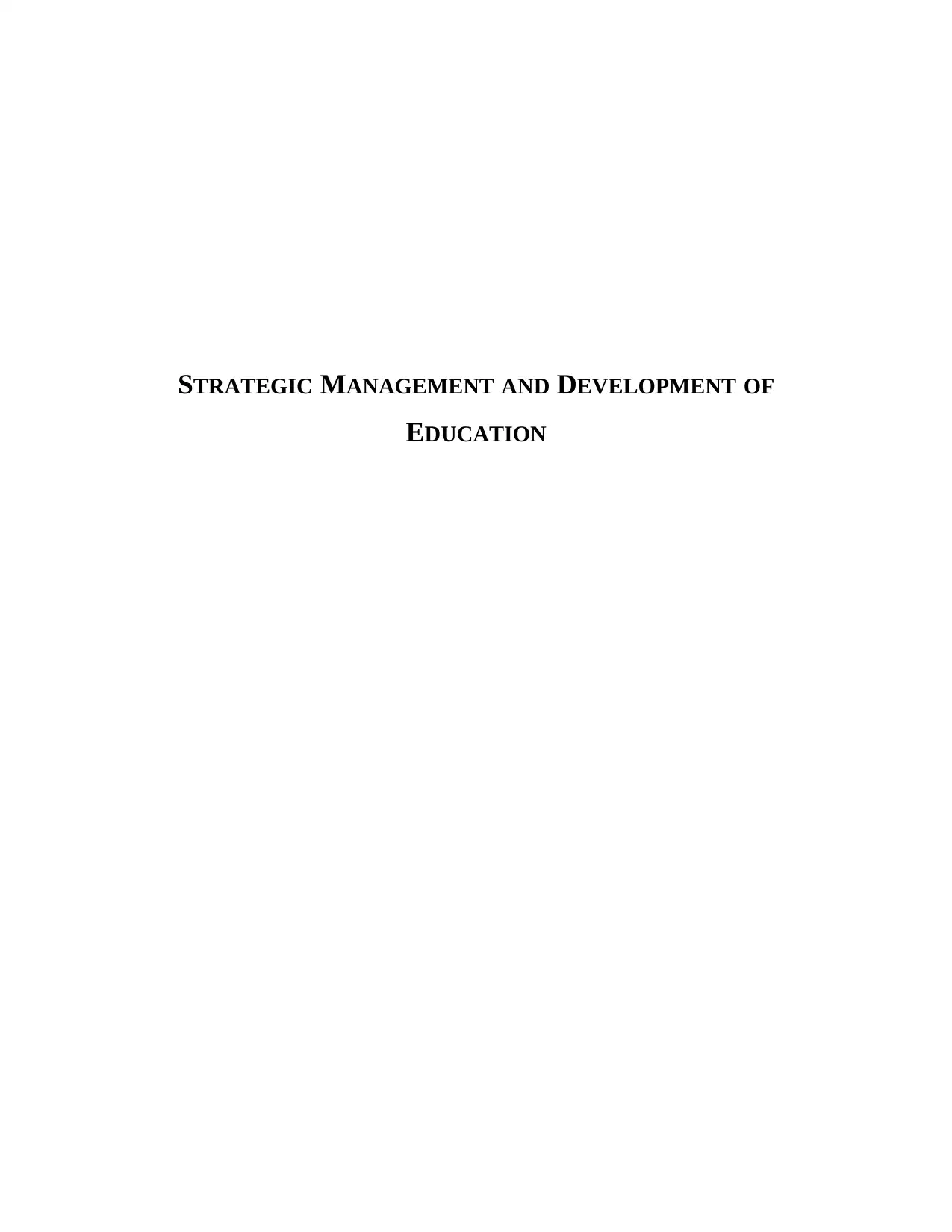
STRATEGIC MANAGEMENT AND DEVELOPMENT OF
EDUCATION
EDUCATION
Secure Best Marks with AI Grader
Need help grading? Try our AI Grader for instant feedback on your assignments.

Table of Contents
Introduction.................................................................................................................................................1
Phase 1 Proposal.........................................................................................................................................1
Phase 2 Literature Review...........................................................................................................................2
Concept and need of strategic management...........................................................................................2
Requirement of organizational restructuring..........................................................................................3
Issues present in the process of organizational restructuring.................................................................4
Impact of organizational restructuring in enhancing business competitiveness.....................................5
Phase 3 Analysis..........................................................................................................................................6
Phase 4 Final Project Report......................................................................................................................10
Communicate recommendation for change..........................................................................................10
Assessed task 2 Strategic professional development portfolio..................................................................12
Phase 1 Introduction.............................................................................................................................12
Phase 2..................................................................................................................................................13
Phase 3..................................................................................................................................................13
References.................................................................................................................................................18
Introduction.................................................................................................................................................1
Phase 1 Proposal.........................................................................................................................................1
Phase 2 Literature Review...........................................................................................................................2
Concept and need of strategic management...........................................................................................2
Requirement of organizational restructuring..........................................................................................3
Issues present in the process of organizational restructuring.................................................................4
Impact of organizational restructuring in enhancing business competitiveness.....................................5
Phase 3 Analysis..........................................................................................................................................6
Phase 4 Final Project Report......................................................................................................................10
Communicate recommendation for change..........................................................................................10
Assessed task 2 Strategic professional development portfolio..................................................................12
Phase 1 Introduction.............................................................................................................................12
Phase 2..................................................................................................................................................13
Phase 3..................................................................................................................................................13
References.................................................................................................................................................18

INTRODUCTION
By generalized meaning, strategic management is regarded as the formulation and
implementation of organizational goals in company's processes. This is entirely managed by the
top authority of the organization wherein the actions are based upon resource capability of the
entity (Hill, Jones and Schilling, 2014). Furthermore, the emphasis is also required to be laid on
external and internal assessment of business environment which has a direct impact on work
processes. The present research study has been made in this context in which focus has been laid
on strategic aspects of the organization and how it provides opportunities for growth and success.
The study has been emphasizing on Tesco which is a largest retail entity operating the
business in the UK. Tesco has been planning to adopt new approaches to restructure
organizational work aspects. Thus, considering the same, the discussion has been included
regarding the contribution of organizational structural aspects on enhancing opportunities for
competitive advantage. Moreover, the study has also been focusing on the scope of restructuring
organizational work dimensions. Alongside, the researcher has also mentioned issues and
challenges that usually arise at the time of restructuring organization. Strategic models have been
applied in the research work to analyze company's external and internal environment.
PHASE 1 PROPOSAL
Tesco is a British multinational grocery seller company, and it is headquartered in
England. The unit head has analyzed that Tesco has been following the hierarchical
organizational structure in which job roles, positions, and activities are divided into different
parts. This aids the business entity to manage all the organizational operations effectively
(Peppard and Ward, 2016). As per the structure, the top management of Tesco has all the
authority to delegate roles and responsibilities among people. Therefore, it can be said that to
enhance the scope of business, Tesco has been following hierarchical organizational structure.
However, there are various issues which Tesco has been experiencing because of hierarchical
structure and that also impact other functions of the business entity.
There are four layers present in the management which generates bureaucracy; hence it
impedes coordination and collaboration level. Therefore, there is a need to restructure
1
By generalized meaning, strategic management is regarded as the formulation and
implementation of organizational goals in company's processes. This is entirely managed by the
top authority of the organization wherein the actions are based upon resource capability of the
entity (Hill, Jones and Schilling, 2014). Furthermore, the emphasis is also required to be laid on
external and internal assessment of business environment which has a direct impact on work
processes. The present research study has been made in this context in which focus has been laid
on strategic aspects of the organization and how it provides opportunities for growth and success.
The study has been emphasizing on Tesco which is a largest retail entity operating the
business in the UK. Tesco has been planning to adopt new approaches to restructure
organizational work aspects. Thus, considering the same, the discussion has been included
regarding the contribution of organizational structural aspects on enhancing opportunities for
competitive advantage. Moreover, the study has also been focusing on the scope of restructuring
organizational work dimensions. Alongside, the researcher has also mentioned issues and
challenges that usually arise at the time of restructuring organization. Strategic models have been
applied in the research work to analyze company's external and internal environment.
PHASE 1 PROPOSAL
Tesco is a British multinational grocery seller company, and it is headquartered in
England. The unit head has analyzed that Tesco has been following the hierarchical
organizational structure in which job roles, positions, and activities are divided into different
parts. This aids the business entity to manage all the organizational operations effectively
(Peppard and Ward, 2016). As per the structure, the top management of Tesco has all the
authority to delegate roles and responsibilities among people. Therefore, it can be said that to
enhance the scope of business, Tesco has been following hierarchical organizational structure.
However, there are various issues which Tesco has been experiencing because of hierarchical
structure and that also impact other functions of the business entity.
There are four layers present in the management which generates bureaucracy; hence it
impedes coordination and collaboration level. Therefore, there is a need to restructure
1
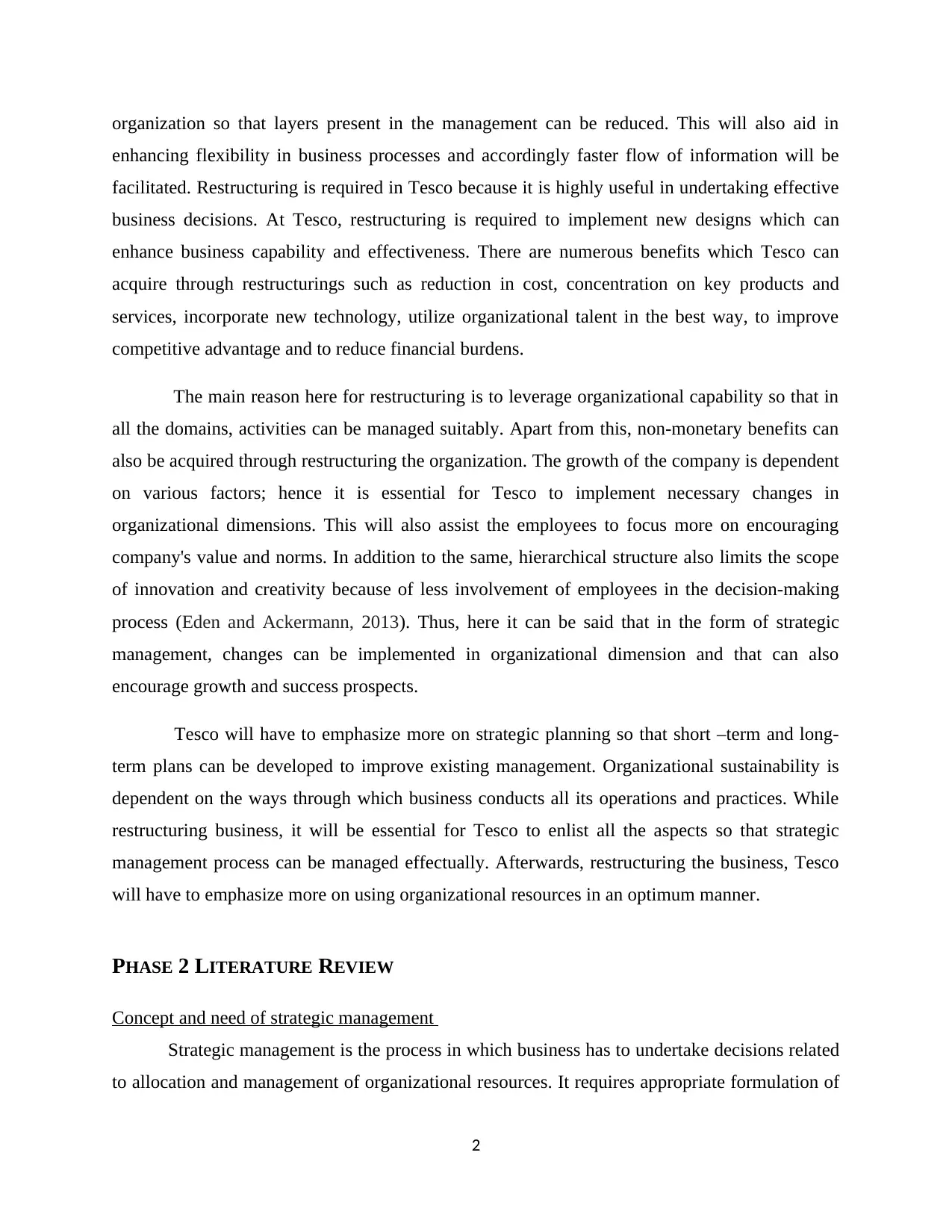
organization so that layers present in the management can be reduced. This will also aid in
enhancing flexibility in business processes and accordingly faster flow of information will be
facilitated. Restructuring is required in Tesco because it is highly useful in undertaking effective
business decisions. At Tesco, restructuring is required to implement new designs which can
enhance business capability and effectiveness. There are numerous benefits which Tesco can
acquire through restructurings such as reduction in cost, concentration on key products and
services, incorporate new technology, utilize organizational talent in the best way, to improve
competitive advantage and to reduce financial burdens.
The main reason here for restructuring is to leverage organizational capability so that in
all the domains, activities can be managed suitably. Apart from this, non-monetary benefits can
also be acquired through restructuring the organization. The growth of the company is dependent
on various factors; hence it is essential for Tesco to implement necessary changes in
organizational dimensions. This will also assist the employees to focus more on encouraging
company's value and norms. In addition to the same, hierarchical structure also limits the scope
of innovation and creativity because of less involvement of employees in the decision-making
process (Eden and Ackermann, 2013). Thus, here it can be said that in the form of strategic
management, changes can be implemented in organizational dimension and that can also
encourage growth and success prospects.
Tesco will have to emphasize more on strategic planning so that short –term and long-
term plans can be developed to improve existing management. Organizational sustainability is
dependent on the ways through which business conducts all its operations and practices. While
restructuring business, it will be essential for Tesco to enlist all the aspects so that strategic
management process can be managed effectually. Afterwards, restructuring the business, Tesco
will have to emphasize more on using organizational resources in an optimum manner.
PHASE 2 LITERATURE REVIEW
Concept and need of strategic management
Strategic management is the process in which business has to undertake decisions related
to allocation and management of organizational resources. It requires appropriate formulation of
2
enhancing flexibility in business processes and accordingly faster flow of information will be
facilitated. Restructuring is required in Tesco because it is highly useful in undertaking effective
business decisions. At Tesco, restructuring is required to implement new designs which can
enhance business capability and effectiveness. There are numerous benefits which Tesco can
acquire through restructurings such as reduction in cost, concentration on key products and
services, incorporate new technology, utilize organizational talent in the best way, to improve
competitive advantage and to reduce financial burdens.
The main reason here for restructuring is to leverage organizational capability so that in
all the domains, activities can be managed suitably. Apart from this, non-monetary benefits can
also be acquired through restructuring the organization. The growth of the company is dependent
on various factors; hence it is essential for Tesco to implement necessary changes in
organizational dimensions. This will also assist the employees to focus more on encouraging
company's value and norms. In addition to the same, hierarchical structure also limits the scope
of innovation and creativity because of less involvement of employees in the decision-making
process (Eden and Ackermann, 2013). Thus, here it can be said that in the form of strategic
management, changes can be implemented in organizational dimension and that can also
encourage growth and success prospects.
Tesco will have to emphasize more on strategic planning so that short –term and long-
term plans can be developed to improve existing management. Organizational sustainability is
dependent on the ways through which business conducts all its operations and practices. While
restructuring business, it will be essential for Tesco to enlist all the aspects so that strategic
management process can be managed effectually. Afterwards, restructuring the business, Tesco
will have to emphasize more on using organizational resources in an optimum manner.
PHASE 2 LITERATURE REVIEW
Concept and need of strategic management
Strategic management is the process in which business has to undertake decisions related
to allocation and management of organizational resources. It requires appropriate formulation of
2
Paraphrase This Document
Need a fresh take? Get an instant paraphrase of this document with our AI Paraphraser
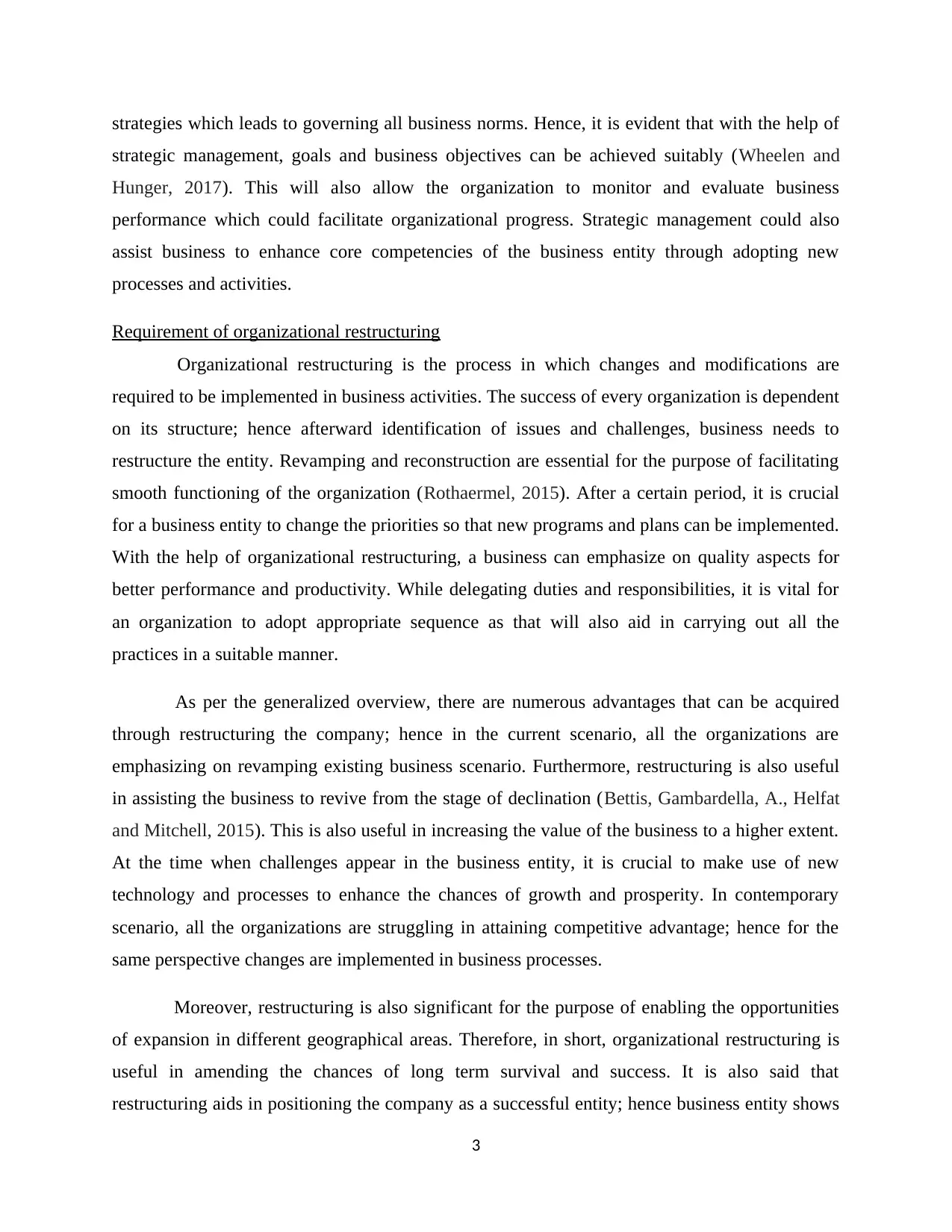
strategies which leads to governing all business norms. Hence, it is evident that with the help of
strategic management, goals and business objectives can be achieved suitably (Wheelen and
Hunger, 2017). This will also allow the organization to monitor and evaluate business
performance which could facilitate organizational progress. Strategic management could also
assist business to enhance core competencies of the business entity through adopting new
processes and activities.
Requirement of organizational restructuring
Organizational restructuring is the process in which changes and modifications are
required to be implemented in business activities. The success of every organization is dependent
on its structure; hence afterward identification of issues and challenges, business needs to
restructure the entity. Revamping and reconstruction are essential for the purpose of facilitating
smooth functioning of the organization (Rothaermel, 2015). After a certain period, it is crucial
for a business entity to change the priorities so that new programs and plans can be implemented.
With the help of organizational restructuring, a business can emphasize on quality aspects for
better performance and productivity. While delegating duties and responsibilities, it is vital for
an organization to adopt appropriate sequence as that will also aid in carrying out all the
practices in a suitable manner.
As per the generalized overview, there are numerous advantages that can be acquired
through restructuring the company; hence in the current scenario, all the organizations are
emphasizing on revamping existing business scenario. Furthermore, restructuring is also useful
in assisting the business to revive from the stage of declination (Bettis, Gambardella, A., Helfat
and Mitchell, 2015). This is also useful in increasing the value of the business to a higher extent.
At the time when challenges appear in the business entity, it is crucial to make use of new
technology and processes to enhance the chances of growth and prosperity. In contemporary
scenario, all the organizations are struggling in attaining competitive advantage; hence for the
same perspective changes are implemented in business processes.
Moreover, restructuring is also significant for the purpose of enabling the opportunities
of expansion in different geographical areas. Therefore, in short, organizational restructuring is
useful in amending the chances of long term survival and success. It is also said that
restructuring aids in positioning the company as a successful entity; hence business entity shows
3
strategic management, goals and business objectives can be achieved suitably (Wheelen and
Hunger, 2017). This will also allow the organization to monitor and evaluate business
performance which could facilitate organizational progress. Strategic management could also
assist business to enhance core competencies of the business entity through adopting new
processes and activities.
Requirement of organizational restructuring
Organizational restructuring is the process in which changes and modifications are
required to be implemented in business activities. The success of every organization is dependent
on its structure; hence afterward identification of issues and challenges, business needs to
restructure the entity. Revamping and reconstruction are essential for the purpose of facilitating
smooth functioning of the organization (Rothaermel, 2015). After a certain period, it is crucial
for a business entity to change the priorities so that new programs and plans can be implemented.
With the help of organizational restructuring, a business can emphasize on quality aspects for
better performance and productivity. While delegating duties and responsibilities, it is vital for
an organization to adopt appropriate sequence as that will also aid in carrying out all the
practices in a suitable manner.
As per the generalized overview, there are numerous advantages that can be acquired
through restructuring the company; hence in the current scenario, all the organizations are
emphasizing on revamping existing business scenario. Furthermore, restructuring is also useful
in assisting the business to revive from the stage of declination (Bettis, Gambardella, A., Helfat
and Mitchell, 2015). This is also useful in increasing the value of the business to a higher extent.
At the time when challenges appear in the business entity, it is crucial to make use of new
technology and processes to enhance the chances of growth and prosperity. In contemporary
scenario, all the organizations are struggling in attaining competitive advantage; hence for the
same perspective changes are implemented in business processes.
Moreover, restructuring is also significant for the purpose of enabling the opportunities
of expansion in different geographical areas. Therefore, in short, organizational restructuring is
useful in amending the chances of long term survival and success. It is also said that
restructuring aids in positioning the company as a successful entity; hence business entity shows
3
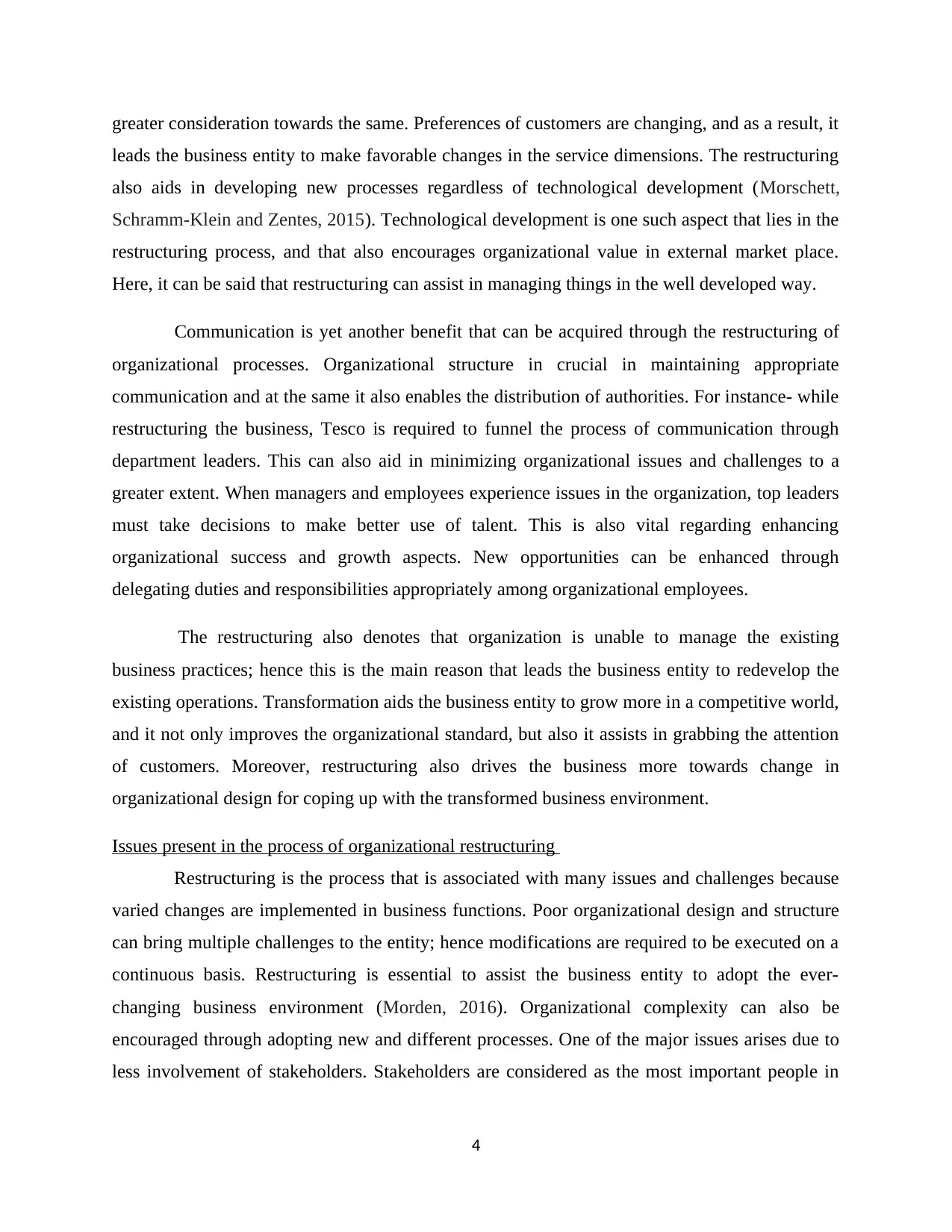
greater consideration towards the same. Preferences of customers are changing, and as a result, it
leads the business entity to make favorable changes in the service dimensions. The restructuring
also aids in developing new processes regardless of technological development (Morschett,
Schramm-Klein and Zentes, 2015). Technological development is one such aspect that lies in the
restructuring process, and that also encourages organizational value in external market place.
Here, it can be said that restructuring can assist in managing things in the well developed way.
Communication is yet another benefit that can be acquired through the restructuring of
organizational processes. Organizational structure in crucial in maintaining appropriate
communication and at the same it also enables the distribution of authorities. For instance- while
restructuring the business, Tesco is required to funnel the process of communication through
department leaders. This can also aid in minimizing organizational issues and challenges to a
greater extent. When managers and employees experience issues in the organization, top leaders
must take decisions to make better use of talent. This is also vital regarding enhancing
organizational success and growth aspects. New opportunities can be enhanced through
delegating duties and responsibilities appropriately among organizational employees.
The restructuring also denotes that organization is unable to manage the existing
business practices; hence this is the main reason that leads the business entity to redevelop the
existing operations. Transformation aids the business entity to grow more in a competitive world,
and it not only improves the organizational standard, but also it assists in grabbing the attention
of customers. Moreover, restructuring also drives the business more towards change in
organizational design for coping up with the transformed business environment.
Issues present in the process of organizational restructuring
Restructuring is the process that is associated with many issues and challenges because
varied changes are implemented in business functions. Poor organizational design and structure
can bring multiple challenges to the entity; hence modifications are required to be executed on a
continuous basis. Restructuring is essential to assist the business entity to adopt the ever-
changing business environment (Morden, 2016). Organizational complexity can also be
encouraged through adopting new and different processes. One of the major issues arises due to
less involvement of stakeholders. Stakeholders are considered as the most important people in
4
leads the business entity to make favorable changes in the service dimensions. The restructuring
also aids in developing new processes regardless of technological development (Morschett,
Schramm-Klein and Zentes, 2015). Technological development is one such aspect that lies in the
restructuring process, and that also encourages organizational value in external market place.
Here, it can be said that restructuring can assist in managing things in the well developed way.
Communication is yet another benefit that can be acquired through the restructuring of
organizational processes. Organizational structure in crucial in maintaining appropriate
communication and at the same it also enables the distribution of authorities. For instance- while
restructuring the business, Tesco is required to funnel the process of communication through
department leaders. This can also aid in minimizing organizational issues and challenges to a
greater extent. When managers and employees experience issues in the organization, top leaders
must take decisions to make better use of talent. This is also vital regarding enhancing
organizational success and growth aspects. New opportunities can be enhanced through
delegating duties and responsibilities appropriately among organizational employees.
The restructuring also denotes that organization is unable to manage the existing
business practices; hence this is the main reason that leads the business entity to redevelop the
existing operations. Transformation aids the business entity to grow more in a competitive world,
and it not only improves the organizational standard, but also it assists in grabbing the attention
of customers. Moreover, restructuring also drives the business more towards change in
organizational design for coping up with the transformed business environment.
Issues present in the process of organizational restructuring
Restructuring is the process that is associated with many issues and challenges because
varied changes are implemented in business functions. Poor organizational design and structure
can bring multiple challenges to the entity; hence modifications are required to be executed on a
continuous basis. Restructuring is essential to assist the business entity to adopt the ever-
changing business environment (Morden, 2016). Organizational complexity can also be
encouraged through adopting new and different processes. One of the major issues arises due to
less involvement of stakeholders. Stakeholders are considered as the most important people in
4
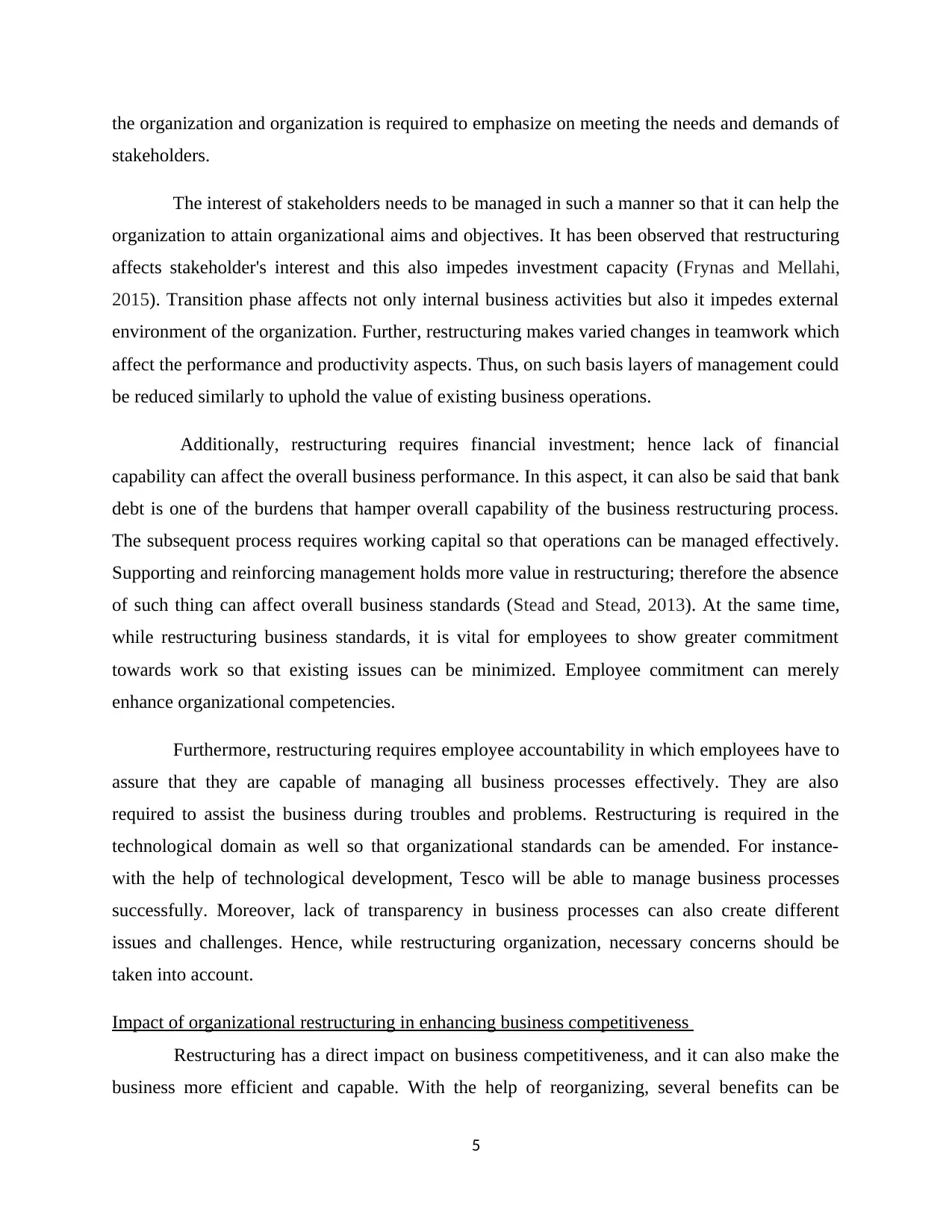
the organization and organization is required to emphasize on meeting the needs and demands of
stakeholders.
The interest of stakeholders needs to be managed in such a manner so that it can help the
organization to attain organizational aims and objectives. It has been observed that restructuring
affects stakeholder's interest and this also impedes investment capacity (Frynas and Mellahi,
2015). Transition phase affects not only internal business activities but also it impedes external
environment of the organization. Further, restructuring makes varied changes in teamwork which
affect the performance and productivity aspects. Thus, on such basis layers of management could
be reduced similarly to uphold the value of existing business operations.
Additionally, restructuring requires financial investment; hence lack of financial
capability can affect the overall business performance. In this aspect, it can also be said that bank
debt is one of the burdens that hamper overall capability of the business restructuring process.
The subsequent process requires working capital so that operations can be managed effectively.
Supporting and reinforcing management holds more value in restructuring; therefore the absence
of such thing can affect overall business standards (Stead and Stead, 2013). At the same time,
while restructuring business standards, it is vital for employees to show greater commitment
towards work so that existing issues can be minimized. Employee commitment can merely
enhance organizational competencies.
Furthermore, restructuring requires employee accountability in which employees have to
assure that they are capable of managing all business processes effectively. They are also
required to assist the business during troubles and problems. Restructuring is required in the
technological domain as well so that organizational standards can be amended. For instance-
with the help of technological development, Tesco will be able to manage business processes
successfully. Moreover, lack of transparency in business processes can also create different
issues and challenges. Hence, while restructuring organization, necessary concerns should be
taken into account.
Impact of organizational restructuring in enhancing business competitiveness
Restructuring has a direct impact on business competitiveness, and it can also make the
business more efficient and capable. With the help of reorganizing, several benefits can be
5
stakeholders.
The interest of stakeholders needs to be managed in such a manner so that it can help the
organization to attain organizational aims and objectives. It has been observed that restructuring
affects stakeholder's interest and this also impedes investment capacity (Frynas and Mellahi,
2015). Transition phase affects not only internal business activities but also it impedes external
environment of the organization. Further, restructuring makes varied changes in teamwork which
affect the performance and productivity aspects. Thus, on such basis layers of management could
be reduced similarly to uphold the value of existing business operations.
Additionally, restructuring requires financial investment; hence lack of financial
capability can affect the overall business performance. In this aspect, it can also be said that bank
debt is one of the burdens that hamper overall capability of the business restructuring process.
The subsequent process requires working capital so that operations can be managed effectively.
Supporting and reinforcing management holds more value in restructuring; therefore the absence
of such thing can affect overall business standards (Stead and Stead, 2013). At the same time,
while restructuring business standards, it is vital for employees to show greater commitment
towards work so that existing issues can be minimized. Employee commitment can merely
enhance organizational competencies.
Furthermore, restructuring requires employee accountability in which employees have to
assure that they are capable of managing all business processes effectively. They are also
required to assist the business during troubles and problems. Restructuring is required in the
technological domain as well so that organizational standards can be amended. For instance-
with the help of technological development, Tesco will be able to manage business processes
successfully. Moreover, lack of transparency in business processes can also create different
issues and challenges. Hence, while restructuring organization, necessary concerns should be
taken into account.
Impact of organizational restructuring in enhancing business competitiveness
Restructuring has a direct impact on business competitiveness, and it can also make the
business more efficient and capable. With the help of reorganizing, several benefits can be
5
Secure Best Marks with AI Grader
Need help grading? Try our AI Grader for instant feedback on your assignments.
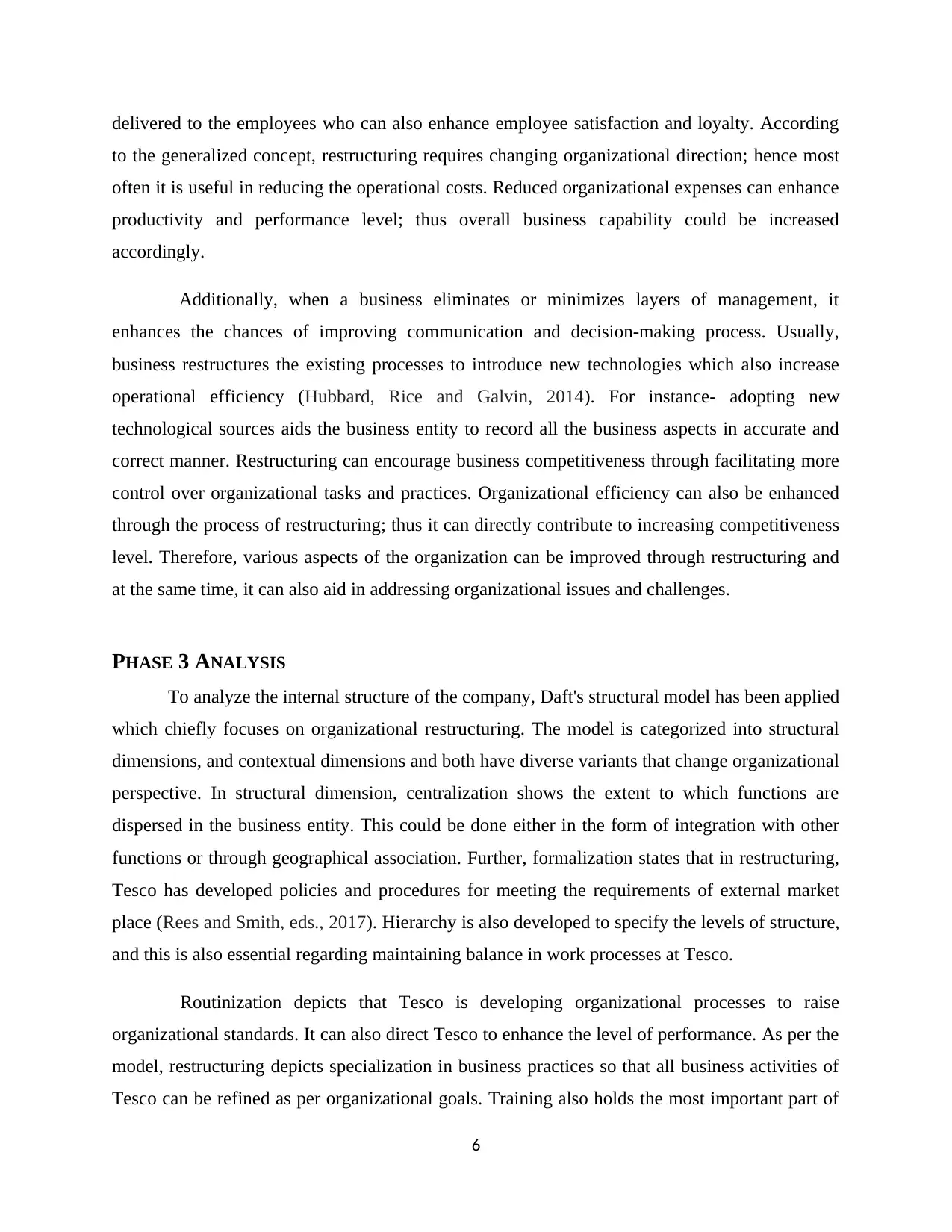
delivered to the employees who can also enhance employee satisfaction and loyalty. According
to the generalized concept, restructuring requires changing organizational direction; hence most
often it is useful in reducing the operational costs. Reduced organizational expenses can enhance
productivity and performance level; thus overall business capability could be increased
accordingly.
Additionally, when a business eliminates or minimizes layers of management, it
enhances the chances of improving communication and decision-making process. Usually,
business restructures the existing processes to introduce new technologies which also increase
operational efficiency (Hubbard, Rice and Galvin, 2014). For instance- adopting new
technological sources aids the business entity to record all the business aspects in accurate and
correct manner. Restructuring can encourage business competitiveness through facilitating more
control over organizational tasks and practices. Organizational efficiency can also be enhanced
through the process of restructuring; thus it can directly contribute to increasing competitiveness
level. Therefore, various aspects of the organization can be improved through restructuring and
at the same time, it can also aid in addressing organizational issues and challenges.
PHASE 3 ANALYSIS
To analyze the internal structure of the company, Daft's structural model has been applied
which chiefly focuses on organizational restructuring. The model is categorized into structural
dimensions, and contextual dimensions and both have diverse variants that change organizational
perspective. In structural dimension, centralization shows the extent to which functions are
dispersed in the business entity. This could be done either in the form of integration with other
functions or through geographical association. Further, formalization states that in restructuring,
Tesco has developed policies and procedures for meeting the requirements of external market
place (Rees and Smith, eds., 2017). Hierarchy is also developed to specify the levels of structure,
and this is also essential regarding maintaining balance in work processes at Tesco.
Routinization depicts that Tesco is developing organizational processes to raise
organizational standards. It can also direct Tesco to enhance the level of performance. As per the
model, restructuring depicts specialization in business practices so that all business activities of
Tesco can be refined as per organizational goals. Training also holds the most important part of
6
to the generalized concept, restructuring requires changing organizational direction; hence most
often it is useful in reducing the operational costs. Reduced organizational expenses can enhance
productivity and performance level; thus overall business capability could be increased
accordingly.
Additionally, when a business eliminates or minimizes layers of management, it
enhances the chances of improving communication and decision-making process. Usually,
business restructures the existing processes to introduce new technologies which also increase
operational efficiency (Hubbard, Rice and Galvin, 2014). For instance- adopting new
technological sources aids the business entity to record all the business aspects in accurate and
correct manner. Restructuring can encourage business competitiveness through facilitating more
control over organizational tasks and practices. Organizational efficiency can also be enhanced
through the process of restructuring; thus it can directly contribute to increasing competitiveness
level. Therefore, various aspects of the organization can be improved through restructuring and
at the same time, it can also aid in addressing organizational issues and challenges.
PHASE 3 ANALYSIS
To analyze the internal structure of the company, Daft's structural model has been applied
which chiefly focuses on organizational restructuring. The model is categorized into structural
dimensions, and contextual dimensions and both have diverse variants that change organizational
perspective. In structural dimension, centralization shows the extent to which functions are
dispersed in the business entity. This could be done either in the form of integration with other
functions or through geographical association. Further, formalization states that in restructuring,
Tesco has developed policies and procedures for meeting the requirements of external market
place (Rees and Smith, eds., 2017). Hierarchy is also developed to specify the levels of structure,
and this is also essential regarding maintaining balance in work processes at Tesco.
Routinization depicts that Tesco is developing organizational processes to raise
organizational standards. It can also direct Tesco to enhance the level of performance. As per the
model, restructuring depicts specialization in business practices so that all business activities of
Tesco can be refined as per organizational goals. Training also holds the most important part of
6
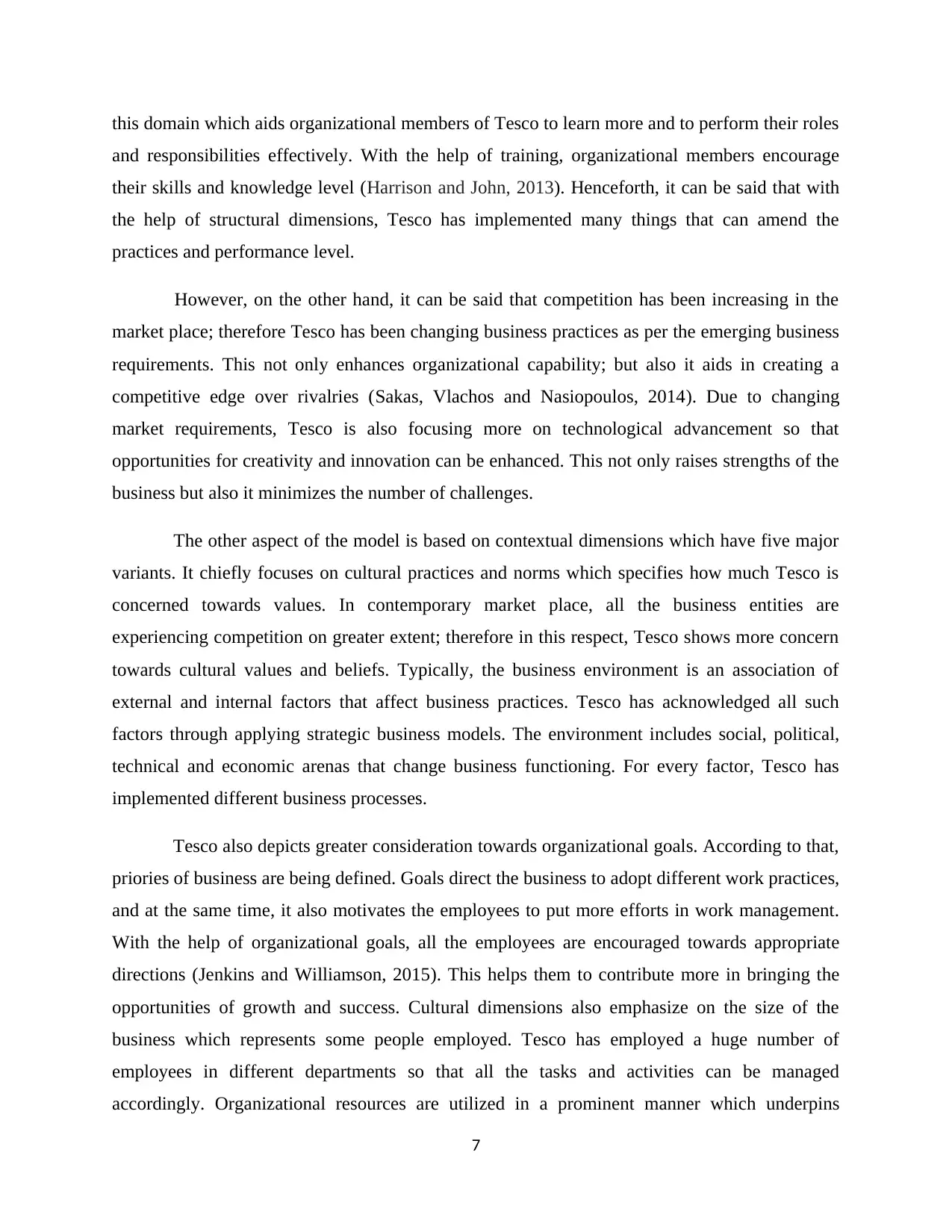
this domain which aids organizational members of Tesco to learn more and to perform their roles
and responsibilities effectively. With the help of training, organizational members encourage
their skills and knowledge level (Harrison and John, 2013). Henceforth, it can be said that with
the help of structural dimensions, Tesco has implemented many things that can amend the
practices and performance level.
However, on the other hand, it can be said that competition has been increasing in the
market place; therefore Tesco has been changing business practices as per the emerging business
requirements. This not only enhances organizational capability; but also it aids in creating a
competitive edge over rivalries (Sakas, Vlachos and Nasiopoulos, 2014). Due to changing
market requirements, Tesco is also focusing more on technological advancement so that
opportunities for creativity and innovation can be enhanced. This not only raises strengths of the
business but also it minimizes the number of challenges.
The other aspect of the model is based on contextual dimensions which have five major
variants. It chiefly focuses on cultural practices and norms which specifies how much Tesco is
concerned towards values. In contemporary market place, all the business entities are
experiencing competition on greater extent; therefore in this respect, Tesco shows more concern
towards cultural values and beliefs. Typically, the business environment is an association of
external and internal factors that affect business practices. Tesco has acknowledged all such
factors through applying strategic business models. The environment includes social, political,
technical and economic arenas that change business functioning. For every factor, Tesco has
implemented different business processes.
Tesco also depicts greater consideration towards organizational goals. According to that,
priories of business are being defined. Goals direct the business to adopt different work practices,
and at the same time, it also motivates the employees to put more efforts in work management.
With the help of organizational goals, all the employees are encouraged towards appropriate
directions (Jenkins and Williamson, 2015). This helps them to contribute more in bringing the
opportunities of growth and success. Cultural dimensions also emphasize on the size of the
business which represents some people employed. Tesco has employed a huge number of
employees in different departments so that all the tasks and activities can be managed
accordingly. Organizational resources are utilized in a prominent manner which underpins
7
and responsibilities effectively. With the help of training, organizational members encourage
their skills and knowledge level (Harrison and John, 2013). Henceforth, it can be said that with
the help of structural dimensions, Tesco has implemented many things that can amend the
practices and performance level.
However, on the other hand, it can be said that competition has been increasing in the
market place; therefore Tesco has been changing business practices as per the emerging business
requirements. This not only enhances organizational capability; but also it aids in creating a
competitive edge over rivalries (Sakas, Vlachos and Nasiopoulos, 2014). Due to changing
market requirements, Tesco is also focusing more on technological advancement so that
opportunities for creativity and innovation can be enhanced. This not only raises strengths of the
business but also it minimizes the number of challenges.
The other aspect of the model is based on contextual dimensions which have five major
variants. It chiefly focuses on cultural practices and norms which specifies how much Tesco is
concerned towards values. In contemporary market place, all the business entities are
experiencing competition on greater extent; therefore in this respect, Tesco shows more concern
towards cultural values and beliefs. Typically, the business environment is an association of
external and internal factors that affect business practices. Tesco has acknowledged all such
factors through applying strategic business models. The environment includes social, political,
technical and economic arenas that change business functioning. For every factor, Tesco has
implemented different business processes.
Tesco also depicts greater consideration towards organizational goals. According to that,
priories of business are being defined. Goals direct the business to adopt different work practices,
and at the same time, it also motivates the employees to put more efforts in work management.
With the help of organizational goals, all the employees are encouraged towards appropriate
directions (Jenkins and Williamson, 2015). This helps them to contribute more in bringing the
opportunities of growth and success. Cultural dimensions also emphasize on the size of the
business which represents some people employed. Tesco has employed a huge number of
employees in different departments so that all the tasks and activities can be managed
accordingly. Organizational resources are utilized in a prominent manner which underpins
7
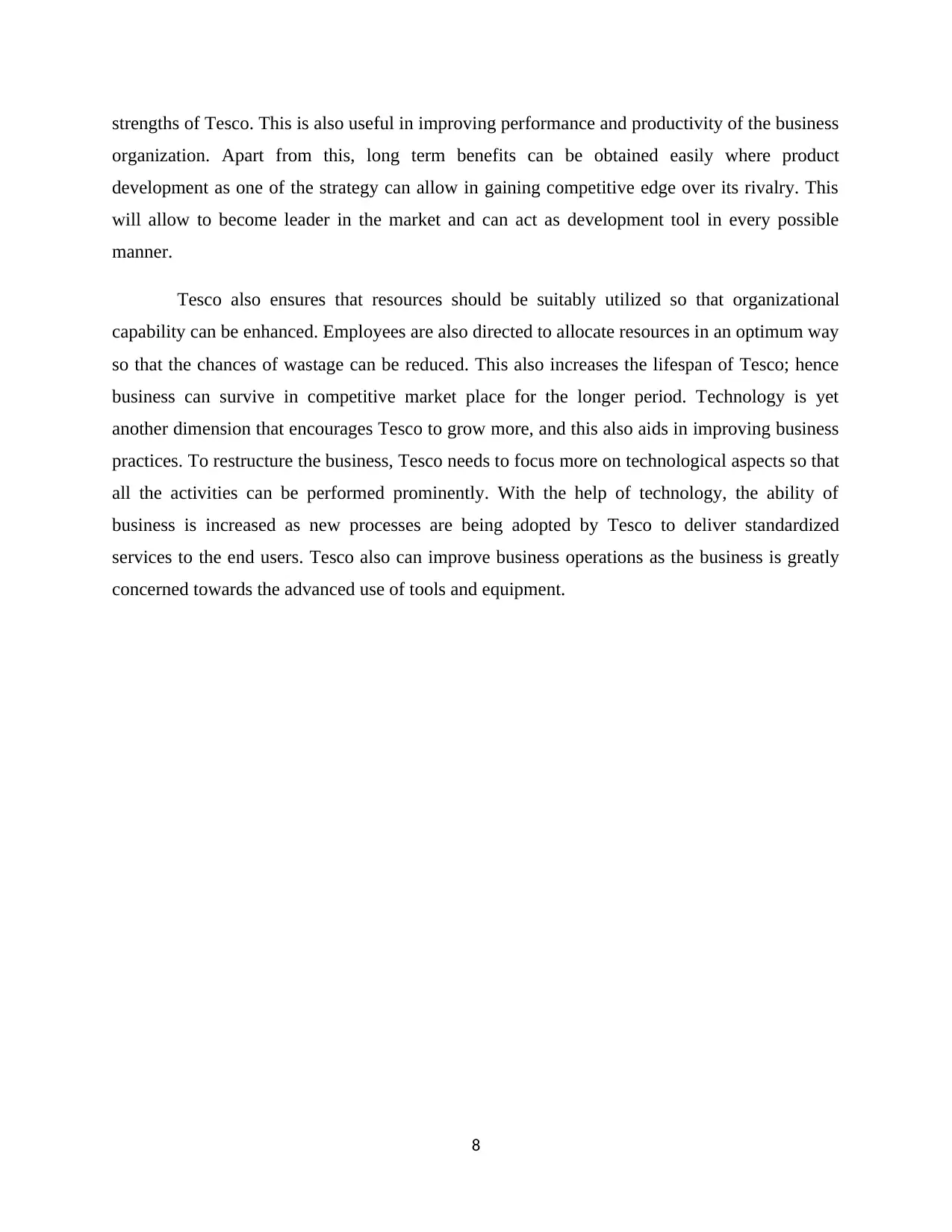
strengths of Tesco. This is also useful in improving performance and productivity of the business
organization. Apart from this, long term benefits can be obtained easily where product
development as one of the strategy can allow in gaining competitive edge over its rivalry. This
will allow to become leader in the market and can act as development tool in every possible
manner.
Tesco also ensures that resources should be suitably utilized so that organizational
capability can be enhanced. Employees are also directed to allocate resources in an optimum way
so that the chances of wastage can be reduced. This also increases the lifespan of Tesco; hence
business can survive in competitive market place for the longer period. Technology is yet
another dimension that encourages Tesco to grow more, and this also aids in improving business
practices. To restructure the business, Tesco needs to focus more on technological aspects so that
all the activities can be performed prominently. With the help of technology, the ability of
business is increased as new processes are being adopted by Tesco to deliver standardized
services to the end users. Tesco also can improve business operations as the business is greatly
concerned towards the advanced use of tools and equipment.
8
organization. Apart from this, long term benefits can be obtained easily where product
development as one of the strategy can allow in gaining competitive edge over its rivalry. This
will allow to become leader in the market and can act as development tool in every possible
manner.
Tesco also ensures that resources should be suitably utilized so that organizational
capability can be enhanced. Employees are also directed to allocate resources in an optimum way
so that the chances of wastage can be reduced. This also increases the lifespan of Tesco; hence
business can survive in competitive market place for the longer period. Technology is yet
another dimension that encourages Tesco to grow more, and this also aids in improving business
practices. To restructure the business, Tesco needs to focus more on technological aspects so that
all the activities can be performed prominently. With the help of technology, the ability of
business is increased as new processes are being adopted by Tesco to deliver standardized
services to the end users. Tesco also can improve business operations as the business is greatly
concerned towards the advanced use of tools and equipment.
8
Paraphrase This Document
Need a fresh take? Get an instant paraphrase of this document with our AI Paraphraser
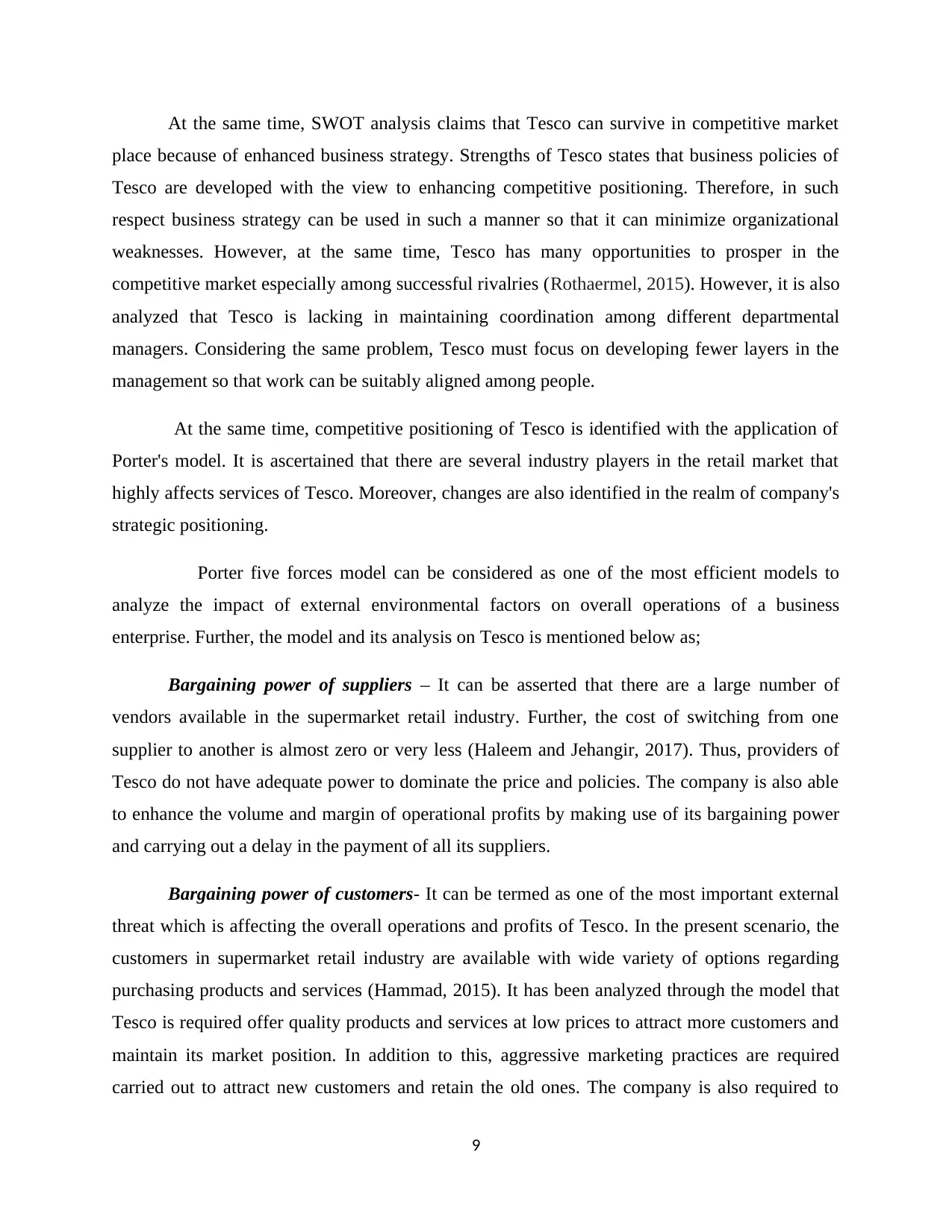
At the same time, SWOT analysis claims that Tesco can survive in competitive market
place because of enhanced business strategy. Strengths of Tesco states that business policies of
Tesco are developed with the view to enhancing competitive positioning. Therefore, in such
respect business strategy can be used in such a manner so that it can minimize organizational
weaknesses. However, at the same time, Tesco has many opportunities to prosper in the
competitive market especially among successful rivalries (Rothaermel, 2015). However, it is also
analyzed that Tesco is lacking in maintaining coordination among different departmental
managers. Considering the same problem, Tesco must focus on developing fewer layers in the
management so that work can be suitably aligned among people.
At the same time, competitive positioning of Tesco is identified with the application of
Porter's model. It is ascertained that there are several industry players in the retail market that
highly affects services of Tesco. Moreover, changes are also identified in the realm of company's
strategic positioning.
Porter five forces model can be considered as one of the most efficient models to
analyze the impact of external environmental factors on overall operations of a business
enterprise. Further, the model and its analysis on Tesco is mentioned below as;
Bargaining power of suppliers – It can be asserted that there are a large number of
vendors available in the supermarket retail industry. Further, the cost of switching from one
supplier to another is almost zero or very less (Haleem and Jehangir, 2017). Thus, providers of
Tesco do not have adequate power to dominate the price and policies. The company is also able
to enhance the volume and margin of operational profits by making use of its bargaining power
and carrying out a delay in the payment of all its suppliers.
Bargaining power of customers- It can be termed as one of the most important external
threat which is affecting the overall operations and profits of Tesco. In the present scenario, the
customers in supermarket retail industry are available with wide variety of options regarding
purchasing products and services (Hammad, 2015). It has been analyzed through the model that
Tesco is required offer quality products and services at low prices to attract more customers and
maintain its market position. In addition to this, aggressive marketing practices are required
carried out to attract new customers and retain the old ones. The company is also required to
9
place because of enhanced business strategy. Strengths of Tesco states that business policies of
Tesco are developed with the view to enhancing competitive positioning. Therefore, in such
respect business strategy can be used in such a manner so that it can minimize organizational
weaknesses. However, at the same time, Tesco has many opportunities to prosper in the
competitive market especially among successful rivalries (Rothaermel, 2015). However, it is also
analyzed that Tesco is lacking in maintaining coordination among different departmental
managers. Considering the same problem, Tesco must focus on developing fewer layers in the
management so that work can be suitably aligned among people.
At the same time, competitive positioning of Tesco is identified with the application of
Porter's model. It is ascertained that there are several industry players in the retail market that
highly affects services of Tesco. Moreover, changes are also identified in the realm of company's
strategic positioning.
Porter five forces model can be considered as one of the most efficient models to
analyze the impact of external environmental factors on overall operations of a business
enterprise. Further, the model and its analysis on Tesco is mentioned below as;
Bargaining power of suppliers – It can be asserted that there are a large number of
vendors available in the supermarket retail industry. Further, the cost of switching from one
supplier to another is almost zero or very less (Haleem and Jehangir, 2017). Thus, providers of
Tesco do not have adequate power to dominate the price and policies. The company is also able
to enhance the volume and margin of operational profits by making use of its bargaining power
and carrying out a delay in the payment of all its suppliers.
Bargaining power of customers- It can be termed as one of the most important external
threat which is affecting the overall operations and profits of Tesco. In the present scenario, the
customers in supermarket retail industry are available with wide variety of options regarding
purchasing products and services (Hammad, 2015). It has been analyzed through the model that
Tesco is required offer quality products and services at low prices to attract more customers and
maintain its market position. In addition to this, aggressive marketing practices are required
carried out to attract new customers and retain the old ones. The company is also required to
9
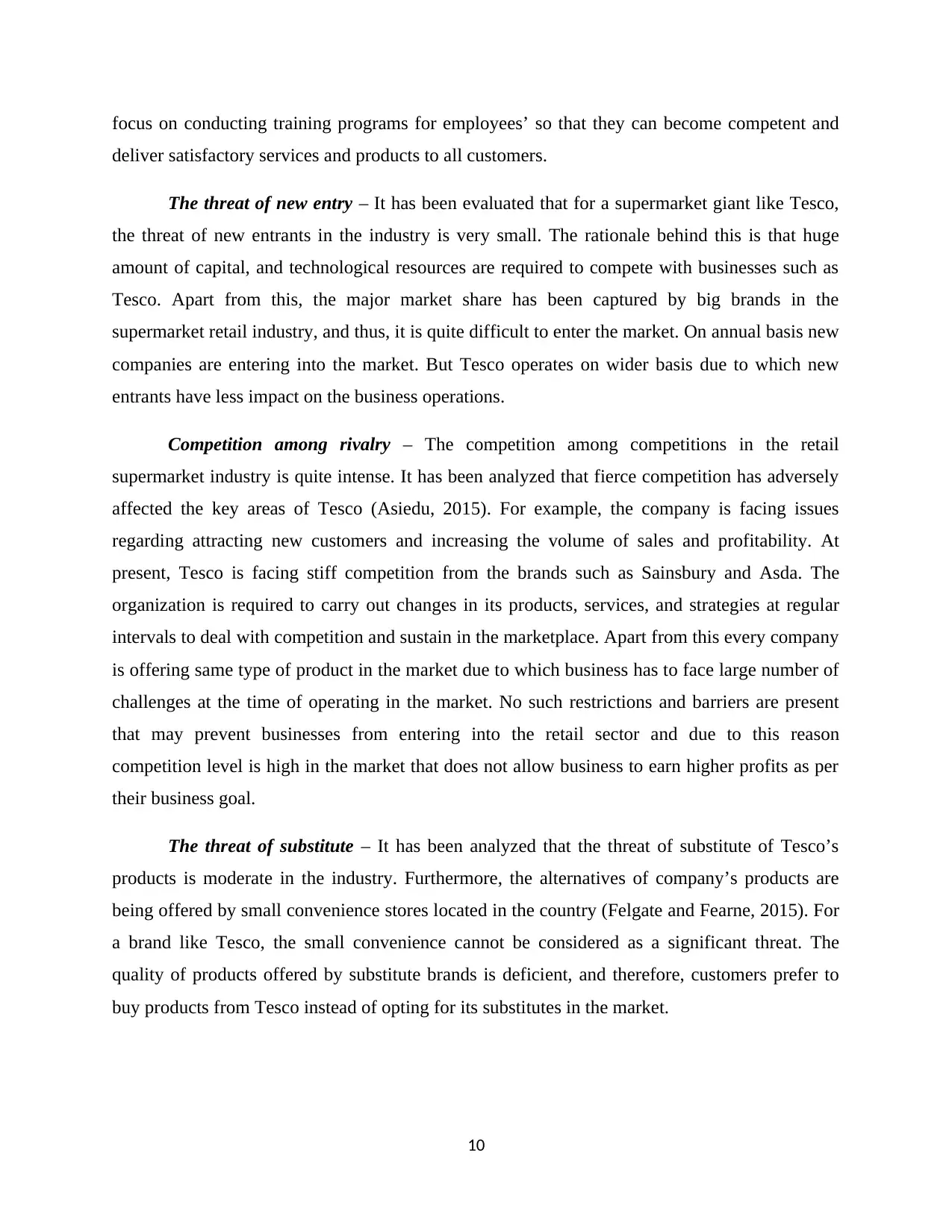
focus on conducting training programs for employees’ so that they can become competent and
deliver satisfactory services and products to all customers.
The threat of new entry – It has been evaluated that for a supermarket giant like Tesco,
the threat of new entrants in the industry is very small. The rationale behind this is that huge
amount of capital, and technological resources are required to compete with businesses such as
Tesco. Apart from this, the major market share has been captured by big brands in the
supermarket retail industry, and thus, it is quite difficult to enter the market. On annual basis new
companies are entering into the market. But Tesco operates on wider basis due to which new
entrants have less impact on the business operations.
Competition among rivalry – The competition among competitions in the retail
supermarket industry is quite intense. It has been analyzed that fierce competition has adversely
affected the key areas of Tesco (Asiedu, 2015). For example, the company is facing issues
regarding attracting new customers and increasing the volume of sales and profitability. At
present, Tesco is facing stiff competition from the brands such as Sainsbury and Asda. The
organization is required to carry out changes in its products, services, and strategies at regular
intervals to deal with competition and sustain in the marketplace. Apart from this every company
is offering same type of product in the market due to which business has to face large number of
challenges at the time of operating in the market. No such restrictions and barriers are present
that may prevent businesses from entering into the retail sector and due to this reason
competition level is high in the market that does not allow business to earn higher profits as per
their business goal.
The threat of substitute – It has been analyzed that the threat of substitute of Tesco’s
products is moderate in the industry. Furthermore, the alternatives of company’s products are
being offered by small convenience stores located in the country (Felgate and Fearne, 2015). For
a brand like Tesco, the small convenience cannot be considered as a significant threat. The
quality of products offered by substitute brands is deficient, and therefore, customers prefer to
buy products from Tesco instead of opting for its substitutes in the market.
10
deliver satisfactory services and products to all customers.
The threat of new entry – It has been evaluated that for a supermarket giant like Tesco,
the threat of new entrants in the industry is very small. The rationale behind this is that huge
amount of capital, and technological resources are required to compete with businesses such as
Tesco. Apart from this, the major market share has been captured by big brands in the
supermarket retail industry, and thus, it is quite difficult to enter the market. On annual basis new
companies are entering into the market. But Tesco operates on wider basis due to which new
entrants have less impact on the business operations.
Competition among rivalry – The competition among competitions in the retail
supermarket industry is quite intense. It has been analyzed that fierce competition has adversely
affected the key areas of Tesco (Asiedu, 2015). For example, the company is facing issues
regarding attracting new customers and increasing the volume of sales and profitability. At
present, Tesco is facing stiff competition from the brands such as Sainsbury and Asda. The
organization is required to carry out changes in its products, services, and strategies at regular
intervals to deal with competition and sustain in the marketplace. Apart from this every company
is offering same type of product in the market due to which business has to face large number of
challenges at the time of operating in the market. No such restrictions and barriers are present
that may prevent businesses from entering into the retail sector and due to this reason
competition level is high in the market that does not allow business to earn higher profits as per
their business goal.
The threat of substitute – It has been analyzed that the threat of substitute of Tesco’s
products is moderate in the industry. Furthermore, the alternatives of company’s products are
being offered by small convenience stores located in the country (Felgate and Fearne, 2015). For
a brand like Tesco, the small convenience cannot be considered as a significant threat. The
quality of products offered by substitute brands is deficient, and therefore, customers prefer to
buy products from Tesco instead of opting for its substitutes in the market.
10
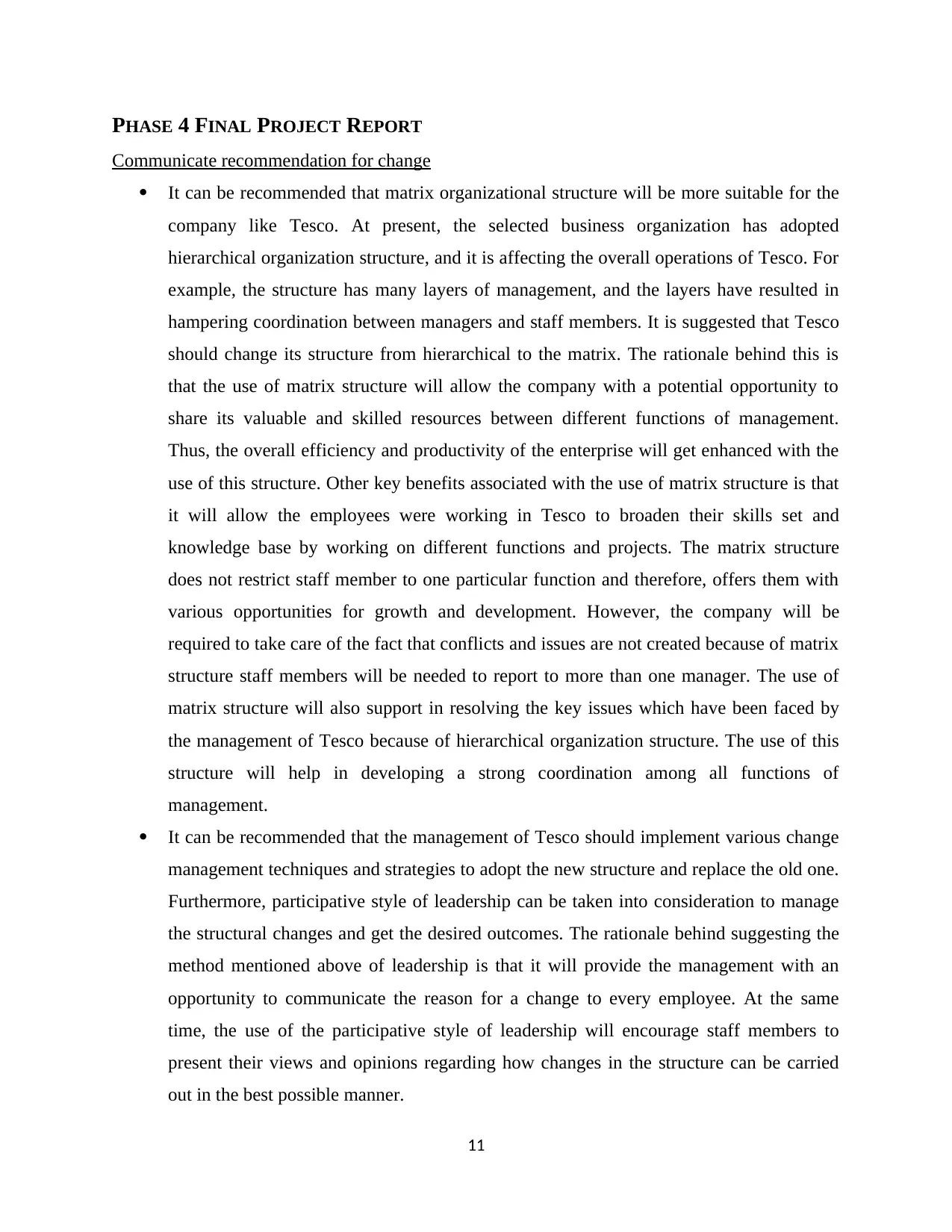
PHASE 4 FINAL PROJECT REPORT
Communicate recommendation for change
It can be recommended that matrix organizational structure will be more suitable for the
company like Tesco. At present, the selected business organization has adopted
hierarchical organization structure, and it is affecting the overall operations of Tesco. For
example, the structure has many layers of management, and the layers have resulted in
hampering coordination between managers and staff members. It is suggested that Tesco
should change its structure from hierarchical to the matrix. The rationale behind this is
that the use of matrix structure will allow the company with a potential opportunity to
share its valuable and skilled resources between different functions of management.
Thus, the overall efficiency and productivity of the enterprise will get enhanced with the
use of this structure. Other key benefits associated with the use of matrix structure is that
it will allow the employees were working in Tesco to broaden their skills set and
knowledge base by working on different functions and projects. The matrix structure
does not restrict staff member to one particular function and therefore, offers them with
various opportunities for growth and development. However, the company will be
required to take care of the fact that conflicts and issues are not created because of matrix
structure staff members will be needed to report to more than one manager. The use of
matrix structure will also support in resolving the key issues which have been faced by
the management of Tesco because of hierarchical organization structure. The use of this
structure will help in developing a strong coordination among all functions of
management.
It can be recommended that the management of Tesco should implement various change
management techniques and strategies to adopt the new structure and replace the old one.
Furthermore, participative style of leadership can be taken into consideration to manage
the structural changes and get the desired outcomes. The rationale behind suggesting the
method mentioned above of leadership is that it will provide the management with an
opportunity to communicate the reason for a change to every employee. At the same
time, the use of the participative style of leadership will encourage staff members to
present their views and opinions regarding how changes in the structure can be carried
out in the best possible manner.
11
Communicate recommendation for change
It can be recommended that matrix organizational structure will be more suitable for the
company like Tesco. At present, the selected business organization has adopted
hierarchical organization structure, and it is affecting the overall operations of Tesco. For
example, the structure has many layers of management, and the layers have resulted in
hampering coordination between managers and staff members. It is suggested that Tesco
should change its structure from hierarchical to the matrix. The rationale behind this is
that the use of matrix structure will allow the company with a potential opportunity to
share its valuable and skilled resources between different functions of management.
Thus, the overall efficiency and productivity of the enterprise will get enhanced with the
use of this structure. Other key benefits associated with the use of matrix structure is that
it will allow the employees were working in Tesco to broaden their skills set and
knowledge base by working on different functions and projects. The matrix structure
does not restrict staff member to one particular function and therefore, offers them with
various opportunities for growth and development. However, the company will be
required to take care of the fact that conflicts and issues are not created because of matrix
structure staff members will be needed to report to more than one manager. The use of
matrix structure will also support in resolving the key issues which have been faced by
the management of Tesco because of hierarchical organization structure. The use of this
structure will help in developing a strong coordination among all functions of
management.
It can be recommended that the management of Tesco should implement various change
management techniques and strategies to adopt the new structure and replace the old one.
Furthermore, participative style of leadership can be taken into consideration to manage
the structural changes and get the desired outcomes. The rationale behind suggesting the
method mentioned above of leadership is that it will provide the management with an
opportunity to communicate the reason for a change to every employee. At the same
time, the use of the participative style of leadership will encourage staff members to
present their views and opinions regarding how changes in the structure can be carried
out in the best possible manner.
11
Secure Best Marks with AI Grader
Need help grading? Try our AI Grader for instant feedback on your assignments.

It can also be recommended that Tesco should also focus on carrying out certain
technological changes within its overall business practices. In the present scenario, the
competition among companies operating in retail supermarket industry has become
highly intense and therefore, it is no longer easy for a company like Tesco to attract new
customers and retain the old one. It is suggested that now the organization should
emphasize on making use of advanced and upgraded technology in its overall business
operations. The rationale behind this is that the use of advanced technology will help
Tesco to serve its customers in fast, accurate and satisfactory manner. In addition to this,
the use of technology will also result in improving the overall effectiveness and
productivity of staff members.
ASSESSED TASK 2 STRATEGIC PROFESSIONAL DEVELOPMENT PORTFOLIO
Phase 1 Introduction
It can be stated that the course module will help me a lot in enhancing my overall
professional. First of all, the module is going to provide me with an overview of an organization
in a professional context. It will help me in understanding various dimensions of organizational
design. In the present scenario, the competition among individuals working in the company has
become highly intense. Therefore, a person is required to emphasize on lifelong learning and
professional development to attain better growth perspectives. The module consists of sections
such as managing by design questions will help me to identify my existing the strengths and
knowledge level. Furthermore, it is also going to reflect the key professional areas where I am
lacking and which needs improvements. It can be expressed that the module includes case
studies of some renowned organizations of the world. The cases are linked to areas such as
management, organization, leadership and belong to my area of interest. These cases will provide
me with insight into these key areas and will support me to enhance my knowledge base
regarding the same.
On the other side of this, the module will also render me with knowledge regarding
different organizational theories and practices. The module will provide me with understanding
and application of various analysis tools that can support me know how big firms such as
Lehman Brothers died and how Bank of America has emerged as industry giant overnight. These
12
technological changes within its overall business practices. In the present scenario, the
competition among companies operating in retail supermarket industry has become
highly intense and therefore, it is no longer easy for a company like Tesco to attract new
customers and retain the old one. It is suggested that now the organization should
emphasize on making use of advanced and upgraded technology in its overall business
operations. The rationale behind this is that the use of advanced technology will help
Tesco to serve its customers in fast, accurate and satisfactory manner. In addition to this,
the use of technology will also result in improving the overall effectiveness and
productivity of staff members.
ASSESSED TASK 2 STRATEGIC PROFESSIONAL DEVELOPMENT PORTFOLIO
Phase 1 Introduction
It can be stated that the course module will help me a lot in enhancing my overall
professional. First of all, the module is going to provide me with an overview of an organization
in a professional context. It will help me in understanding various dimensions of organizational
design. In the present scenario, the competition among individuals working in the company has
become highly intense. Therefore, a person is required to emphasize on lifelong learning and
professional development to attain better growth perspectives. The module consists of sections
such as managing by design questions will help me to identify my existing the strengths and
knowledge level. Furthermore, it is also going to reflect the key professional areas where I am
lacking and which needs improvements. It can be expressed that the module includes case
studies of some renowned organizations of the world. The cases are linked to areas such as
management, organization, leadership and belong to my area of interest. These cases will provide
me with insight into these key areas and will support me to enhance my knowledge base
regarding the same.
On the other side of this, the module will also render me with knowledge regarding
different organizational theories and practices. The module will provide me with understanding
and application of various analysis tools that can support me know how big firms such as
Lehman Brothers died and how Bank of America has emerged as industry giant overnight. These
12
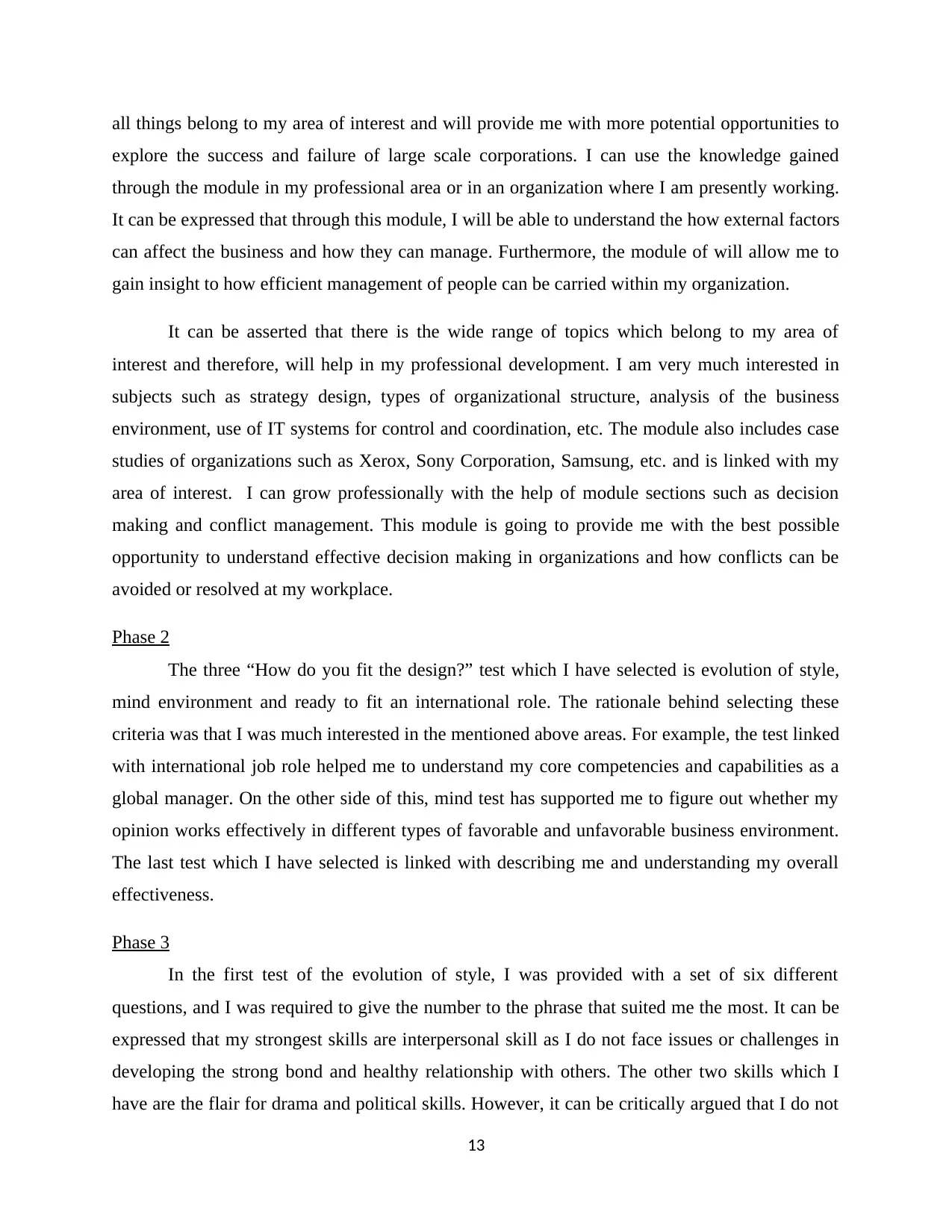
all things belong to my area of interest and will provide me with more potential opportunities to
explore the success and failure of large scale corporations. I can use the knowledge gained
through the module in my professional area or in an organization where I am presently working.
It can be expressed that through this module, I will be able to understand the how external factors
can affect the business and how they can manage. Furthermore, the module of will allow me to
gain insight to how efficient management of people can be carried within my organization.
It can be asserted that there is the wide range of topics which belong to my area of
interest and therefore, will help in my professional development. I am very much interested in
subjects such as strategy design, types of organizational structure, analysis of the business
environment, use of IT systems for control and coordination, etc. The module also includes case
studies of organizations such as Xerox, Sony Corporation, Samsung, etc. and is linked with my
area of interest. I can grow professionally with the help of module sections such as decision
making and conflict management. This module is going to provide me with the best possible
opportunity to understand effective decision making in organizations and how conflicts can be
avoided or resolved at my workplace.
Phase 2
The three “How do you fit the design?” test which I have selected is evolution of style,
mind environment and ready to fit an international role. The rationale behind selecting these
criteria was that I was much interested in the mentioned above areas. For example, the test linked
with international job role helped me to understand my core competencies and capabilities as a
global manager. On the other side of this, mind test has supported me to figure out whether my
opinion works effectively in different types of favorable and unfavorable business environment.
The last test which I have selected is linked with describing me and understanding my overall
effectiveness.
Phase 3
In the first test of the evolution of style, I was provided with a set of six different
questions, and I was required to give the number to the phrase that suited me the most. It can be
expressed that my strongest skills are interpersonal skill as I do not face issues or challenges in
developing the strong bond and healthy relationship with others. The other two skills which I
have are the flair for drama and political skills. However, it can be critically argued that I do not
13
explore the success and failure of large scale corporations. I can use the knowledge gained
through the module in my professional area or in an organization where I am presently working.
It can be expressed that through this module, I will be able to understand the how external factors
can affect the business and how they can manage. Furthermore, the module of will allow me to
gain insight to how efficient management of people can be carried within my organization.
It can be asserted that there is the wide range of topics which belong to my area of
interest and therefore, will help in my professional development. I am very much interested in
subjects such as strategy design, types of organizational structure, analysis of the business
environment, use of IT systems for control and coordination, etc. The module also includes case
studies of organizations such as Xerox, Sony Corporation, Samsung, etc. and is linked with my
area of interest. I can grow professionally with the help of module sections such as decision
making and conflict management. This module is going to provide me with the best possible
opportunity to understand effective decision making in organizations and how conflicts can be
avoided or resolved at my workplace.
Phase 2
The three “How do you fit the design?” test which I have selected is evolution of style,
mind environment and ready to fit an international role. The rationale behind selecting these
criteria was that I was much interested in the mentioned above areas. For example, the test linked
with international job role helped me to understand my core competencies and capabilities as a
global manager. On the other side of this, mind test has supported me to figure out whether my
opinion works effectively in different types of favorable and unfavorable business environment.
The last test which I have selected is linked with describing me and understanding my overall
effectiveness.
Phase 3
In the first test of the evolution of style, I was provided with a set of six different
questions, and I was required to give the number to the phrase that suited me the most. It can be
expressed that my strongest skills are interpersonal skill as I do not face issues or challenges in
developing the strong bond and healthy relationship with others. The other two skills which I
have are the flair for drama and political skills. However, it can be critically argued that I do not
13
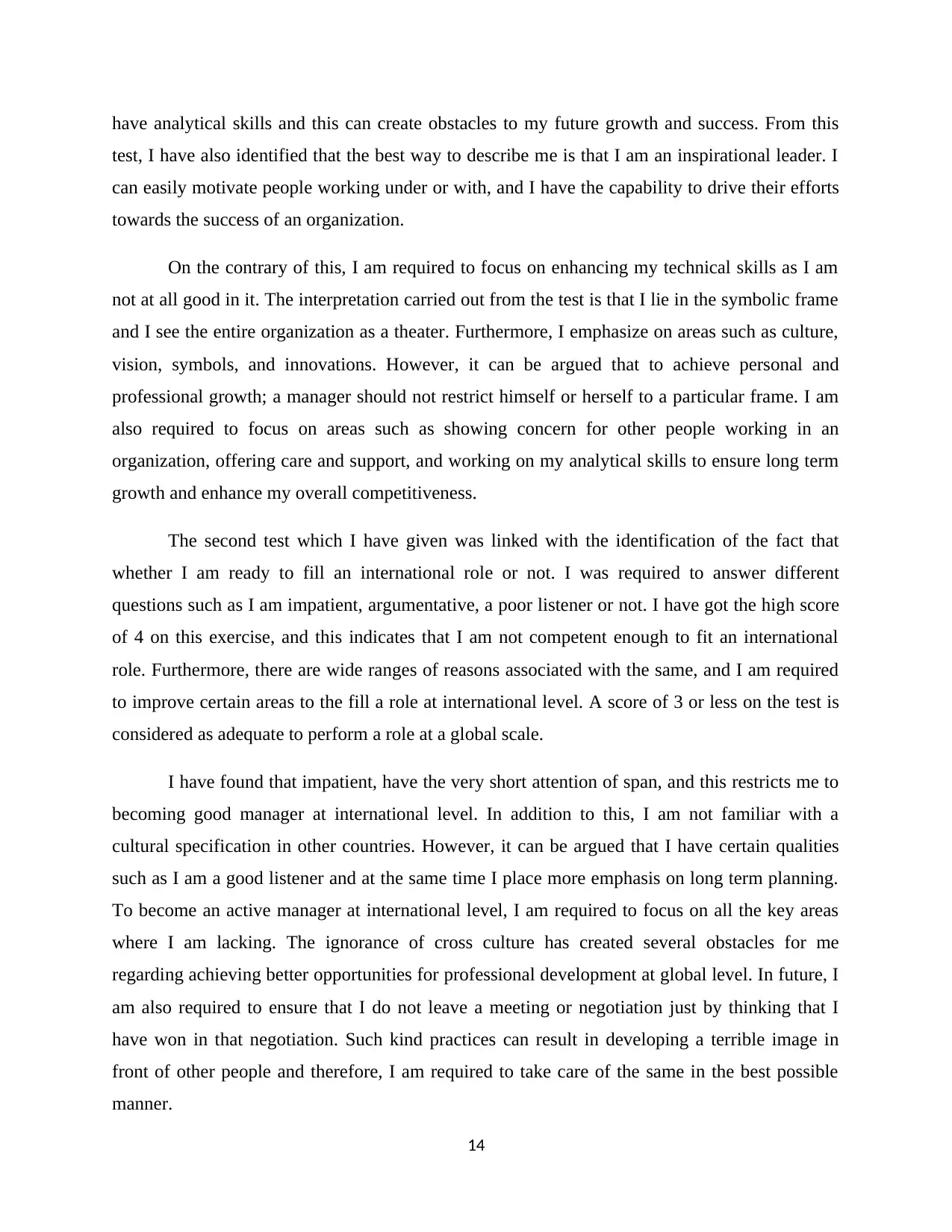
have analytical skills and this can create obstacles to my future growth and success. From this
test, I have also identified that the best way to describe me is that I am an inspirational leader. I
can easily motivate people working under or with, and I have the capability to drive their efforts
towards the success of an organization.
On the contrary of this, I am required to focus on enhancing my technical skills as I am
not at all good in it. The interpretation carried out from the test is that I lie in the symbolic frame
and I see the entire organization as a theater. Furthermore, I emphasize on areas such as culture,
vision, symbols, and innovations. However, it can be argued that to achieve personal and
professional growth; a manager should not restrict himself or herself to a particular frame. I am
also required to focus on areas such as showing concern for other people working in an
organization, offering care and support, and working on my analytical skills to ensure long term
growth and enhance my overall competitiveness.
The second test which I have given was linked with the identification of the fact that
whether I am ready to fill an international role or not. I was required to answer different
questions such as I am impatient, argumentative, a poor listener or not. I have got the high score
of 4 on this exercise, and this indicates that I am not competent enough to fit an international
role. Furthermore, there are wide ranges of reasons associated with the same, and I am required
to improve certain areas to the fill a role at international level. A score of 3 or less on the test is
considered as adequate to perform a role at a global scale.
I have found that impatient, have the very short attention of span, and this restricts me to
becoming good manager at international level. In addition to this, I am not familiar with a
cultural specification in other countries. However, it can be argued that I have certain qualities
such as I am a good listener and at the same time I place more emphasis on long term planning.
To become an active manager at international level, I am required to focus on all the key areas
where I am lacking. The ignorance of cross culture has created several obstacles for me
regarding achieving better opportunities for professional development at global level. In future, I
am also required to ensure that I do not leave a meeting or negotiation just by thinking that I
have won in that negotiation. Such kind practices can result in developing a terrible image in
front of other people and therefore, I am required to take care of the same in the best possible
manner.
14
test, I have also identified that the best way to describe me is that I am an inspirational leader. I
can easily motivate people working under or with, and I have the capability to drive their efforts
towards the success of an organization.
On the contrary of this, I am required to focus on enhancing my technical skills as I am
not at all good in it. The interpretation carried out from the test is that I lie in the symbolic frame
and I see the entire organization as a theater. Furthermore, I emphasize on areas such as culture,
vision, symbols, and innovations. However, it can be argued that to achieve personal and
professional growth; a manager should not restrict himself or herself to a particular frame. I am
also required to focus on areas such as showing concern for other people working in an
organization, offering care and support, and working on my analytical skills to ensure long term
growth and enhance my overall competitiveness.
The second test which I have given was linked with the identification of the fact that
whether I am ready to fill an international role or not. I was required to answer different
questions such as I am impatient, argumentative, a poor listener or not. I have got the high score
of 4 on this exercise, and this indicates that I am not competent enough to fit an international
role. Furthermore, there are wide ranges of reasons associated with the same, and I am required
to improve certain areas to the fill a role at international level. A score of 3 or less on the test is
considered as adequate to perform a role at a global scale.
I have found that impatient, have the very short attention of span, and this restricts me to
becoming good manager at international level. In addition to this, I am not familiar with a
cultural specification in other countries. However, it can be argued that I have certain qualities
such as I am a good listener and at the same time I place more emphasis on long term planning.
To become an active manager at international level, I am required to focus on all the key areas
where I am lacking. The ignorance of cross culture has created several obstacles for me
regarding achieving better opportunities for professional development at global level. In future, I
am also required to ensure that I do not leave a meeting or negotiation just by thinking that I
have won in that negotiation. Such kind practices can result in developing a terrible image in
front of other people and therefore, I am required to take care of the same in the best possible
manner.
14
Paraphrase This Document
Need a fresh take? Get an instant paraphrase of this document with our AI Paraphraser
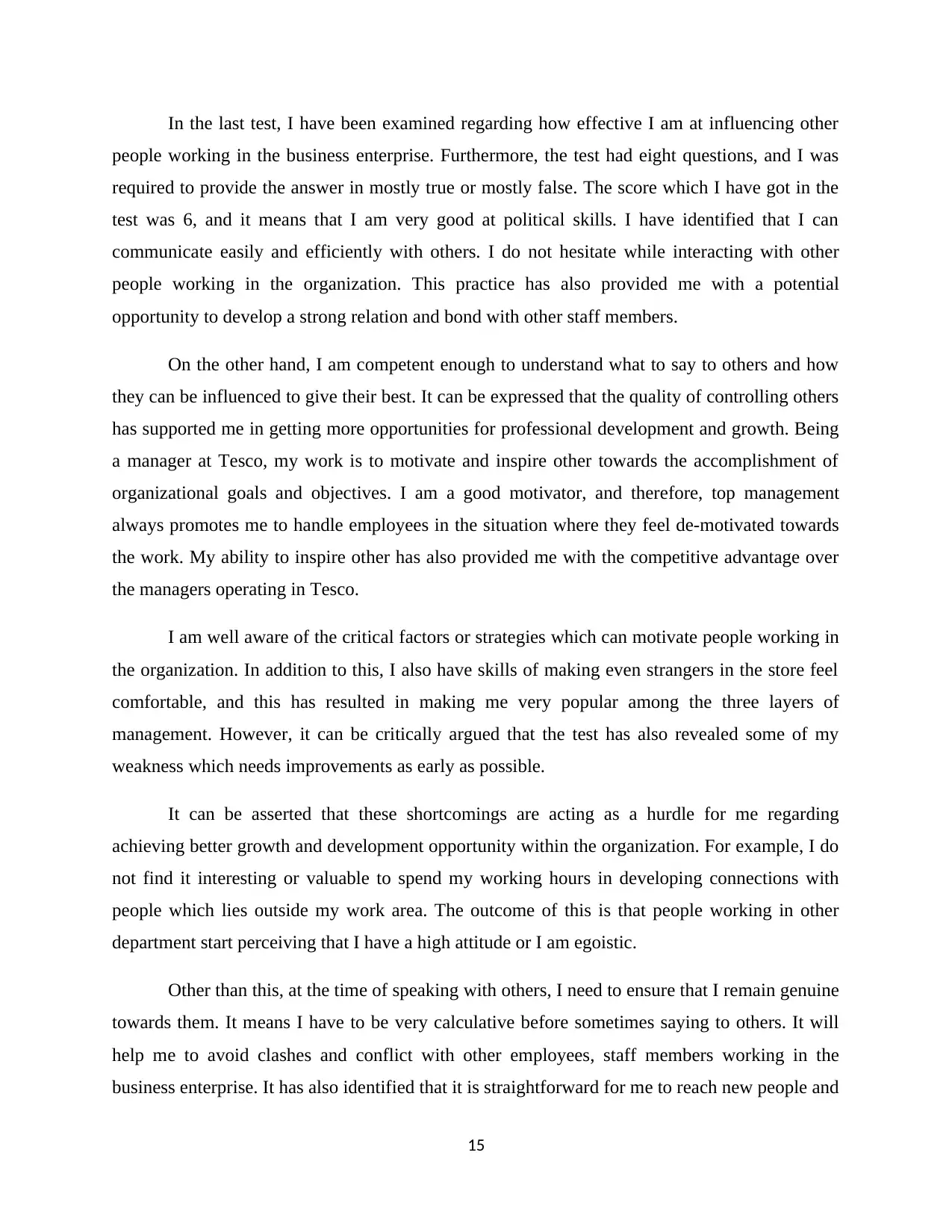
In the last test, I have been examined regarding how effective I am at influencing other
people working in the business enterprise. Furthermore, the test had eight questions, and I was
required to provide the answer in mostly true or mostly false. The score which I have got in the
test was 6, and it means that I am very good at political skills. I have identified that I can
communicate easily and efficiently with others. I do not hesitate while interacting with other
people working in the organization. This practice has also provided me with a potential
opportunity to develop a strong relation and bond with other staff members.
On the other hand, I am competent enough to understand what to say to others and how
they can be influenced to give their best. It can be expressed that the quality of controlling others
has supported me in getting more opportunities for professional development and growth. Being
a manager at Tesco, my work is to motivate and inspire other towards the accomplishment of
organizational goals and objectives. I am a good motivator, and therefore, top management
always promotes me to handle employees in the situation where they feel de-motivated towards
the work. My ability to inspire other has also provided me with the competitive advantage over
the managers operating in Tesco.
I am well aware of the critical factors or strategies which can motivate people working in
the organization. In addition to this, I also have skills of making even strangers in the store feel
comfortable, and this has resulted in making me very popular among the three layers of
management. However, it can be critically argued that the test has also revealed some of my
weakness which needs improvements as early as possible.
It can be asserted that these shortcomings are acting as a hurdle for me regarding
achieving better growth and development opportunity within the organization. For example, I do
not find it interesting or valuable to spend my working hours in developing connections with
people which lies outside my work area. The outcome of this is that people working in other
department start perceiving that I have a high attitude or I am egoistic.
Other than this, at the time of speaking with others, I need to ensure that I remain genuine
towards them. It means I have to be very calculative before sometimes saying to others. It will
help me to avoid clashes and conflict with other employees, staff members working in the
business enterprise. It has also identified that it is straightforward for me to reach new people and
15
people working in the business enterprise. Furthermore, the test had eight questions, and I was
required to provide the answer in mostly true or mostly false. The score which I have got in the
test was 6, and it means that I am very good at political skills. I have identified that I can
communicate easily and efficiently with others. I do not hesitate while interacting with other
people working in the organization. This practice has also provided me with a potential
opportunity to develop a strong relation and bond with other staff members.
On the other hand, I am competent enough to understand what to say to others and how
they can be influenced to give their best. It can be expressed that the quality of controlling others
has supported me in getting more opportunities for professional development and growth. Being
a manager at Tesco, my work is to motivate and inspire other towards the accomplishment of
organizational goals and objectives. I am a good motivator, and therefore, top management
always promotes me to handle employees in the situation where they feel de-motivated towards
the work. My ability to inspire other has also provided me with the competitive advantage over
the managers operating in Tesco.
I am well aware of the critical factors or strategies which can motivate people working in
the organization. In addition to this, I also have skills of making even strangers in the store feel
comfortable, and this has resulted in making me very popular among the three layers of
management. However, it can be critically argued that the test has also revealed some of my
weakness which needs improvements as early as possible.
It can be asserted that these shortcomings are acting as a hurdle for me regarding
achieving better growth and development opportunity within the organization. For example, I do
not find it interesting or valuable to spend my working hours in developing connections with
people which lies outside my work area. The outcome of this is that people working in other
department start perceiving that I have a high attitude or I am egoistic.
Other than this, at the time of speaking with others, I need to ensure that I remain genuine
towards them. It means I have to be very calculative before sometimes saying to others. It will
help me to avoid clashes and conflict with other employees, staff members working in the
business enterprise. It has also identified that it is straightforward for me to reach new people and
15

interact with them. It supports in developing a strong sense of satisfaction among others and in
my overall professional development. The result of this test indicates that I am quite capable as a
manager and have the capability to lead others in the best possible manner. At the same time, it
has reflected some of my weaknesses which I need to overcome to attract better growth and
employment opportunities in the future.
Phase 4
Activity Current status Future goals Time frame
Enhancing the
existing patience
level
At present, I am
quire impatient and
have a short
attention span
In future, I will be
looking forward to
enhance my patience and
ability to have keen
attention to each and
every detail during
conversation
8 months
Argumentative Currently, I am very
argumentative and
this has acted as a
hurdle in terms of
developing long
term relationship
with others
I will try to ensure that I
am not involved in any
arguments and listen to
the views and opinions
of other people
4 months
Developing
knowledge about
culture of other
countries
I don’t have
knowledge regarding
the overall cultural
practices carried out
in other countries.
The results of this is
that I am not
considered as
capable to fill a role
In future, I will be
looking forward to
enhance my knowledge
and understanding the
culture of other
countries. It will be done
through strategies such
as travelling to other
nations and e-learning.
1 year
16
my overall professional development. The result of this test indicates that I am quite capable as a
manager and have the capability to lead others in the best possible manner. At the same time, it
has reflected some of my weaknesses which I need to overcome to attract better growth and
employment opportunities in the future.
Phase 4
Activity Current status Future goals Time frame
Enhancing the
existing patience
level
At present, I am
quire impatient and
have a short
attention span
In future, I will be
looking forward to
enhance my patience and
ability to have keen
attention to each and
every detail during
conversation
8 months
Argumentative Currently, I am very
argumentative and
this has acted as a
hurdle in terms of
developing long
term relationship
with others
I will try to ensure that I
am not involved in any
arguments and listen to
the views and opinions
of other people
4 months
Developing
knowledge about
culture of other
countries
I don’t have
knowledge regarding
the overall cultural
practices carried out
in other countries.
The results of this is
that I am not
considered as
capable to fill a role
In future, I will be
looking forward to
enhance my knowledge
and understanding the
culture of other
countries. It will be done
through strategies such
as travelling to other
nations and e-learning.
1 year
16
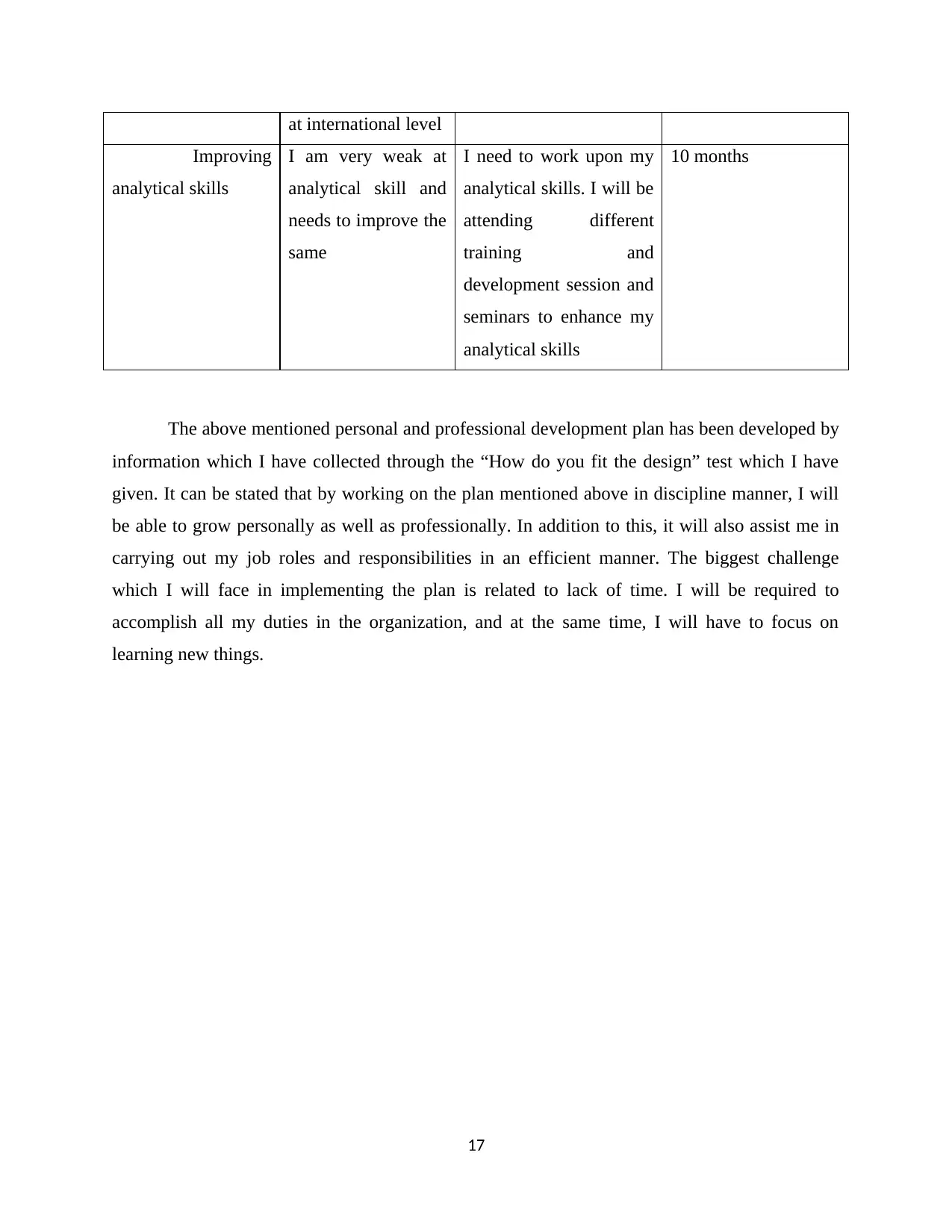
at international level
Improving
analytical skills
I am very weak at
analytical skill and
needs to improve the
same
I need to work upon my
analytical skills. I will be
attending different
training and
development session and
seminars to enhance my
analytical skills
10 months
The above mentioned personal and professional development plan has been developed by
information which I have collected through the “How do you fit the design” test which I have
given. It can be stated that by working on the plan mentioned above in discipline manner, I will
be able to grow personally as well as professionally. In addition to this, it will also assist me in
carrying out my job roles and responsibilities in an efficient manner. The biggest challenge
which I will face in implementing the plan is related to lack of time. I will be required to
accomplish all my duties in the organization, and at the same time, I will have to focus on
learning new things.
17
Improving
analytical skills
I am very weak at
analytical skill and
needs to improve the
same
I need to work upon my
analytical skills. I will be
attending different
training and
development session and
seminars to enhance my
analytical skills
10 months
The above mentioned personal and professional development plan has been developed by
information which I have collected through the “How do you fit the design” test which I have
given. It can be stated that by working on the plan mentioned above in discipline manner, I will
be able to grow personally as well as professionally. In addition to this, it will also assist me in
carrying out my job roles and responsibilities in an efficient manner. The biggest challenge
which I will face in implementing the plan is related to lack of time. I will be required to
accomplish all my duties in the organization, and at the same time, I will have to focus on
learning new things.
17
Secure Best Marks with AI Grader
Need help grading? Try our AI Grader for instant feedback on your assignments.
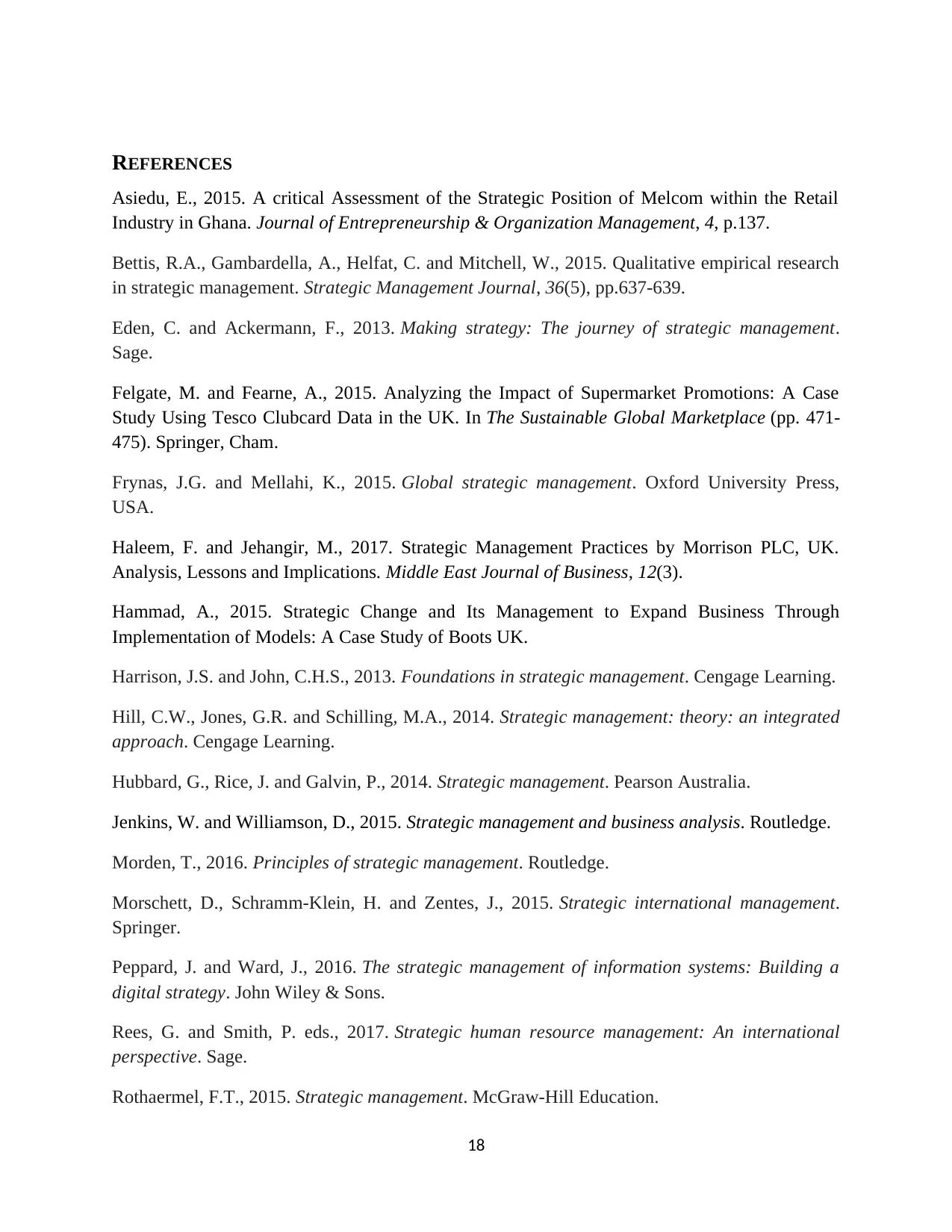
REFERENCES
Asiedu, E., 2015. A critical Assessment of the Strategic Position of Melcom within the Retail
Industry in Ghana. Journal of Entrepreneurship & Organization Management, 4, p.137.
Bettis, R.A., Gambardella, A., Helfat, C. and Mitchell, W., 2015. Qualitative empirical research
in strategic management. Strategic Management Journal, 36(5), pp.637-639.
Eden, C. and Ackermann, F., 2013. Making strategy: The journey of strategic management.
Sage.
Felgate, M. and Fearne, A., 2015. Analyzing the Impact of Supermarket Promotions: A Case
Study Using Tesco Clubcard Data in the UK. In The Sustainable Global Marketplace (pp. 471-
475). Springer, Cham.
Frynas, J.G. and Mellahi, K., 2015. Global strategic management. Oxford University Press,
USA.
Haleem, F. and Jehangir, M., 2017. Strategic Management Practices by Morrison PLC, UK.
Analysis, Lessons and Implications. Middle East Journal of Business, 12(3).
Hammad, A., 2015. Strategic Change and Its Management to Expand Business Through
Implementation of Models: A Case Study of Boots UK.
Harrison, J.S. and John, C.H.S., 2013. Foundations in strategic management. Cengage Learning.
Hill, C.W., Jones, G.R. and Schilling, M.A., 2014. Strategic management: theory: an integrated
approach. Cengage Learning.
Hubbard, G., Rice, J. and Galvin, P., 2014. Strategic management. Pearson Australia.
Jenkins, W. and Williamson, D., 2015. Strategic management and business analysis. Routledge.
Morden, T., 2016. Principles of strategic management. Routledge.
Morschett, D., Schramm-Klein, H. and Zentes, J., 2015. Strategic international management.
Springer.
Peppard, J. and Ward, J., 2016. The strategic management of information systems: Building a
digital strategy. John Wiley & Sons.
Rees, G. and Smith, P. eds., 2017. Strategic human resource management: An international
perspective. Sage.
Rothaermel, F.T., 2015. Strategic management. McGraw-Hill Education.
18
Asiedu, E., 2015. A critical Assessment of the Strategic Position of Melcom within the Retail
Industry in Ghana. Journal of Entrepreneurship & Organization Management, 4, p.137.
Bettis, R.A., Gambardella, A., Helfat, C. and Mitchell, W., 2015. Qualitative empirical research
in strategic management. Strategic Management Journal, 36(5), pp.637-639.
Eden, C. and Ackermann, F., 2013. Making strategy: The journey of strategic management.
Sage.
Felgate, M. and Fearne, A., 2015. Analyzing the Impact of Supermarket Promotions: A Case
Study Using Tesco Clubcard Data in the UK. In The Sustainable Global Marketplace (pp. 471-
475). Springer, Cham.
Frynas, J.G. and Mellahi, K., 2015. Global strategic management. Oxford University Press,
USA.
Haleem, F. and Jehangir, M., 2017. Strategic Management Practices by Morrison PLC, UK.
Analysis, Lessons and Implications. Middle East Journal of Business, 12(3).
Hammad, A., 2015. Strategic Change and Its Management to Expand Business Through
Implementation of Models: A Case Study of Boots UK.
Harrison, J.S. and John, C.H.S., 2013. Foundations in strategic management. Cengage Learning.
Hill, C.W., Jones, G.R. and Schilling, M.A., 2014. Strategic management: theory: an integrated
approach. Cengage Learning.
Hubbard, G., Rice, J. and Galvin, P., 2014. Strategic management. Pearson Australia.
Jenkins, W. and Williamson, D., 2015. Strategic management and business analysis. Routledge.
Morden, T., 2016. Principles of strategic management. Routledge.
Morschett, D., Schramm-Klein, H. and Zentes, J., 2015. Strategic international management.
Springer.
Peppard, J. and Ward, J., 2016. The strategic management of information systems: Building a
digital strategy. John Wiley & Sons.
Rees, G. and Smith, P. eds., 2017. Strategic human resource management: An international
perspective. Sage.
Rothaermel, F.T., 2015. Strategic management. McGraw-Hill Education.
18

Sakas, D., Vlachos, D. and Nasiopoulos, D., 2014. Modelling strategic management for the
development of competitive advantage, based on technology. Journal of Systems and
Information Technology, 16(3), pp.187-209.
Stead, J.G. and Stead, W.E., 2013. Sustainable strategic management. ME Sharpe.
Wheelen, T.L. and Hunger, J.D., 2017. Strategic management and business policy. pearson.
19
development of competitive advantage, based on technology. Journal of Systems and
Information Technology, 16(3), pp.187-209.
Stead, J.G. and Stead, W.E., 2013. Sustainable strategic management. ME Sharpe.
Wheelen, T.L. and Hunger, J.D., 2017. Strategic management and business policy. pearson.
19
1 out of 21
Related Documents
Your All-in-One AI-Powered Toolkit for Academic Success.
+13062052269
info@desklib.com
Available 24*7 on WhatsApp / Email
![[object Object]](/_next/static/media/star-bottom.7253800d.svg)
Unlock your academic potential
© 2024 | Zucol Services PVT LTD | All rights reserved.





